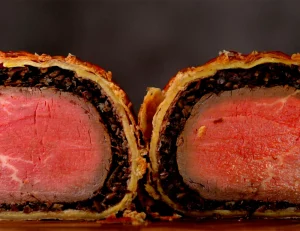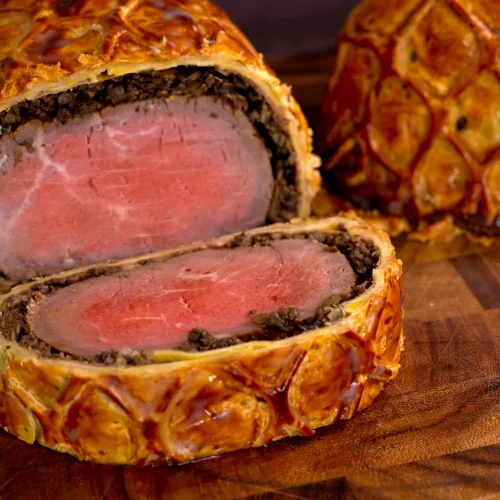Beef Wellington (Filetto in Crosta alla Wellington in Italian) is one of the world’s most famous dish for meat lovers. It is a seared beef tenderloin, wrapped in mushrooms, prosciutto, a crêpe and finally puffed pastry. This show-stopping dish can seem daunting for beginners. That’s why we are sharing with you PIATTO™’s foolproof Beef Wellington recipe!
Here’s a look at the Beef Wellington we prepared for the 2022 holiday season, cooked to medium rare:
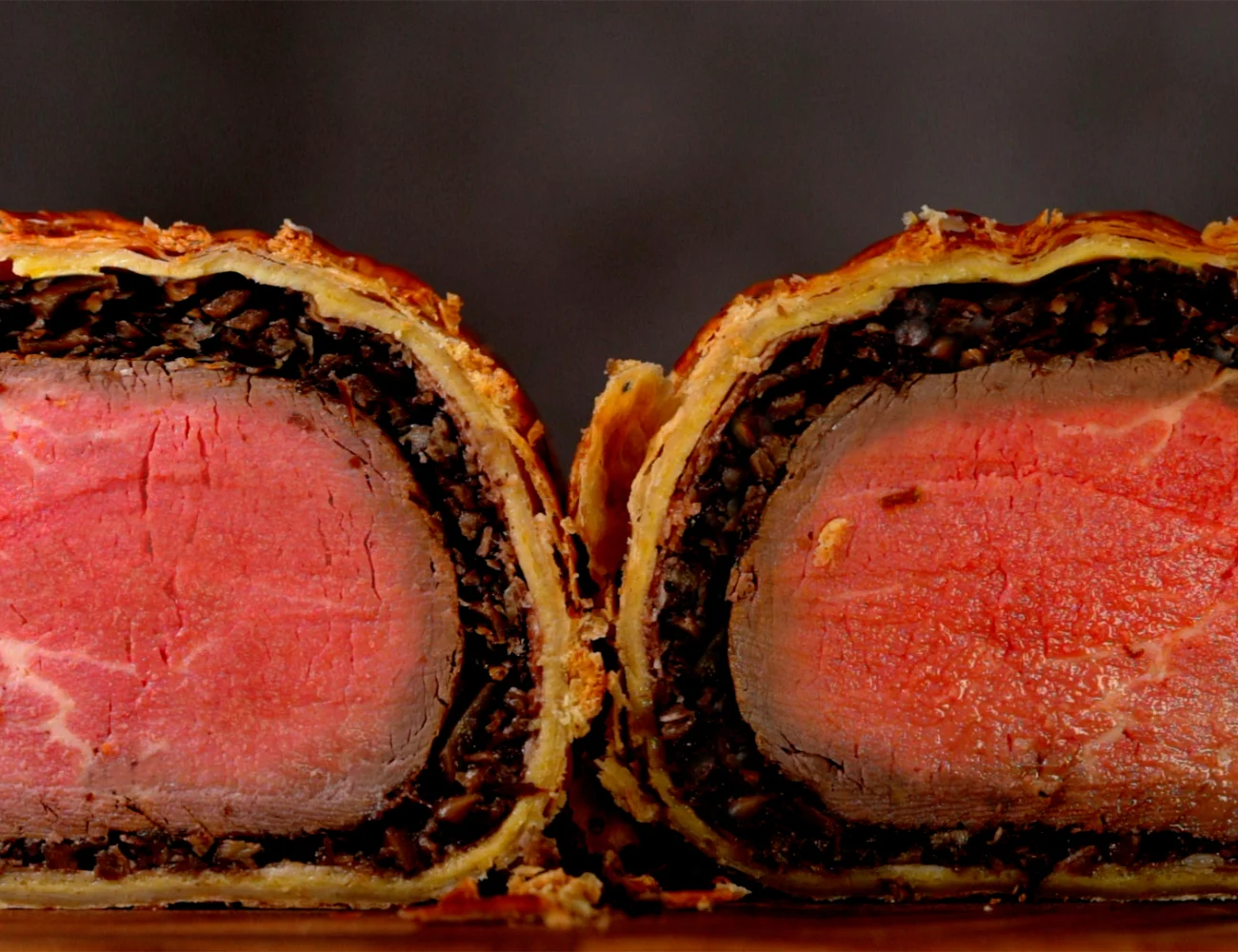
Watch the Video Recipe!
Learn how to make our Beef Wellington recipe in this video, filmed in Italy. Turn on the subtitles to watch it in English. Video with English narration? Coming soon!
Subscribe to our YouTube Channel
More video recipes? Subscribe to our YouTube Channel (it’s FREE) and click the bell to get notifications when we release a new video recipe!
Beef Wellington Recipe Ingredients
Any Beef Wellington recipe consists of 3-5 parts (starting from the inside and working out):
- beef tenderloin
- a pate or duxelles (a rough, seasoned paste made of finely chopped mixed mushrooms)
- sweet prosciutto (Prosciutto di Parma) – optional
- crêpe – optional
- puff pastry
Beef Tenderloin
The tenderloin is found between the ribs of the cow, next to the backbone. It has a ‘butt’ and a ‘tail’ side. Three cuts are taken from the tenderloin (butt, center, tail). It is the center cut that we are looking for to make the Beef Wellington. Here, we are cutting our piece of filet (fillet) down to just that cut:
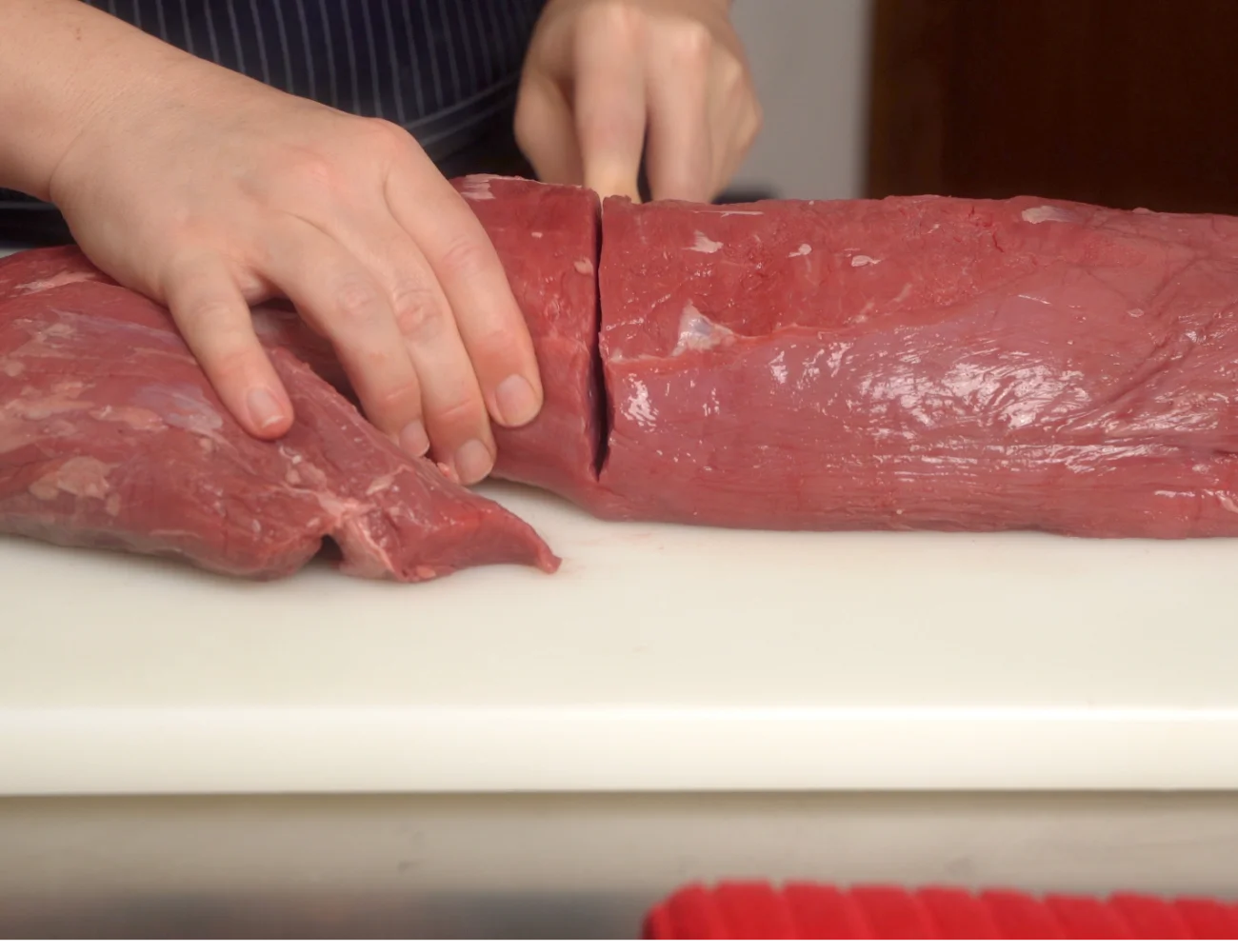
The filet (or fillet) needs to be salted on all sides. Then, you need to wrap the salted filet in plastic wrap and let it rest for 2 hours! The resting stage is not optional, if you want to make a perfect Beef Wellington!
The rest gives the salt time to penetrate the beef inside and for the process of osmosis to reabsorb all of the juice that the salt calls to the surface of the meat.
In fact, a common error that beginners make is to salt the meat, but not to give time for the juice to reabsorb. In other words, they don’t let the meat rest long enough. This error can result in a loss of flavor and a terrible sear.
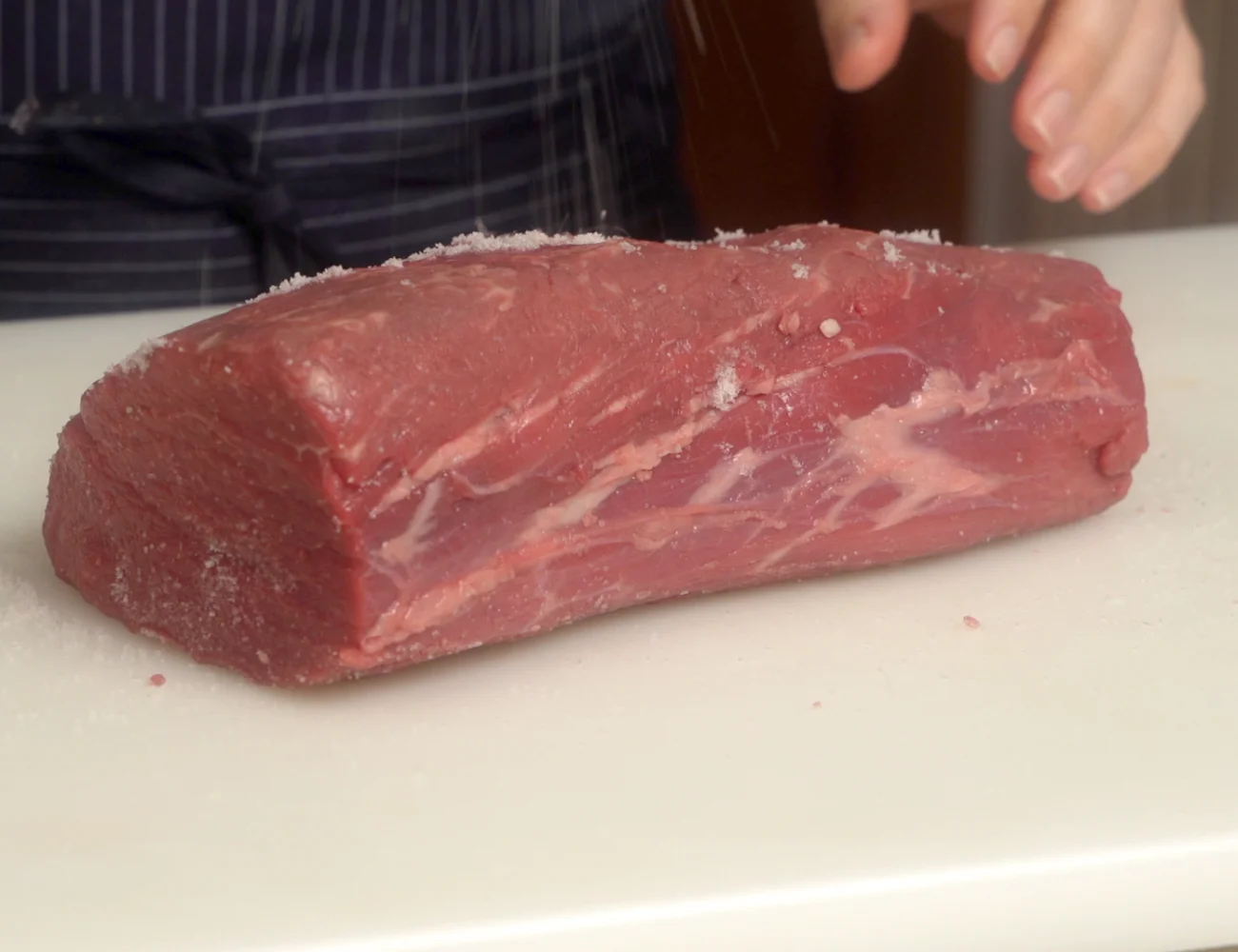
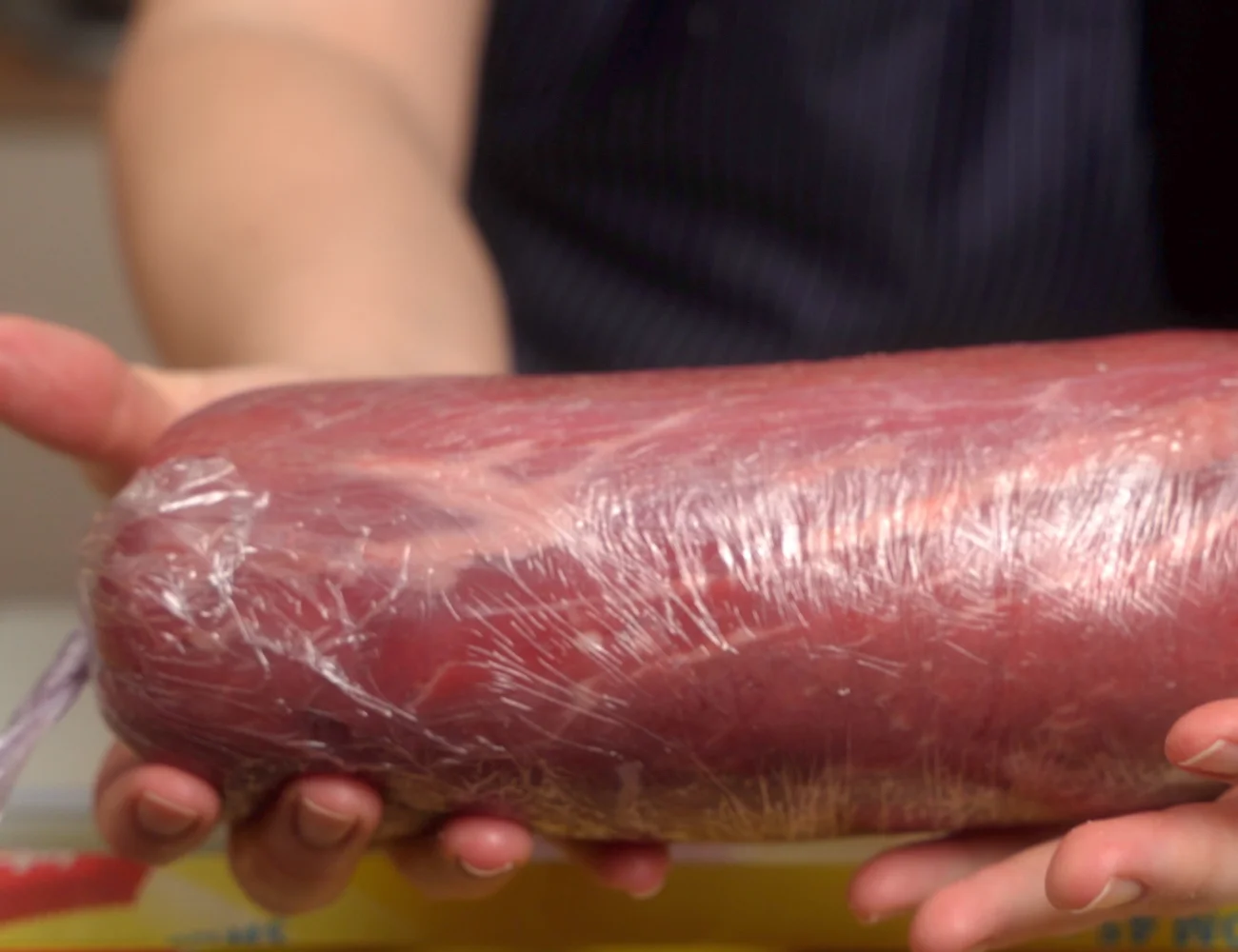
After the fillet (filet) is left to rest, it is time to brown it! This is done with a bit of clarified butter (butter that has a high smoke point). Learn how to make clarified butter at home from normal butter in our guide!
Once the tenderloin has been seared on all sides over high heat, we deglaze it with cognac! This imparts a lovely flavor and also lets us deglaze the pan, saving all of those drippings to make a demi glace for serving our Beef Wellington!
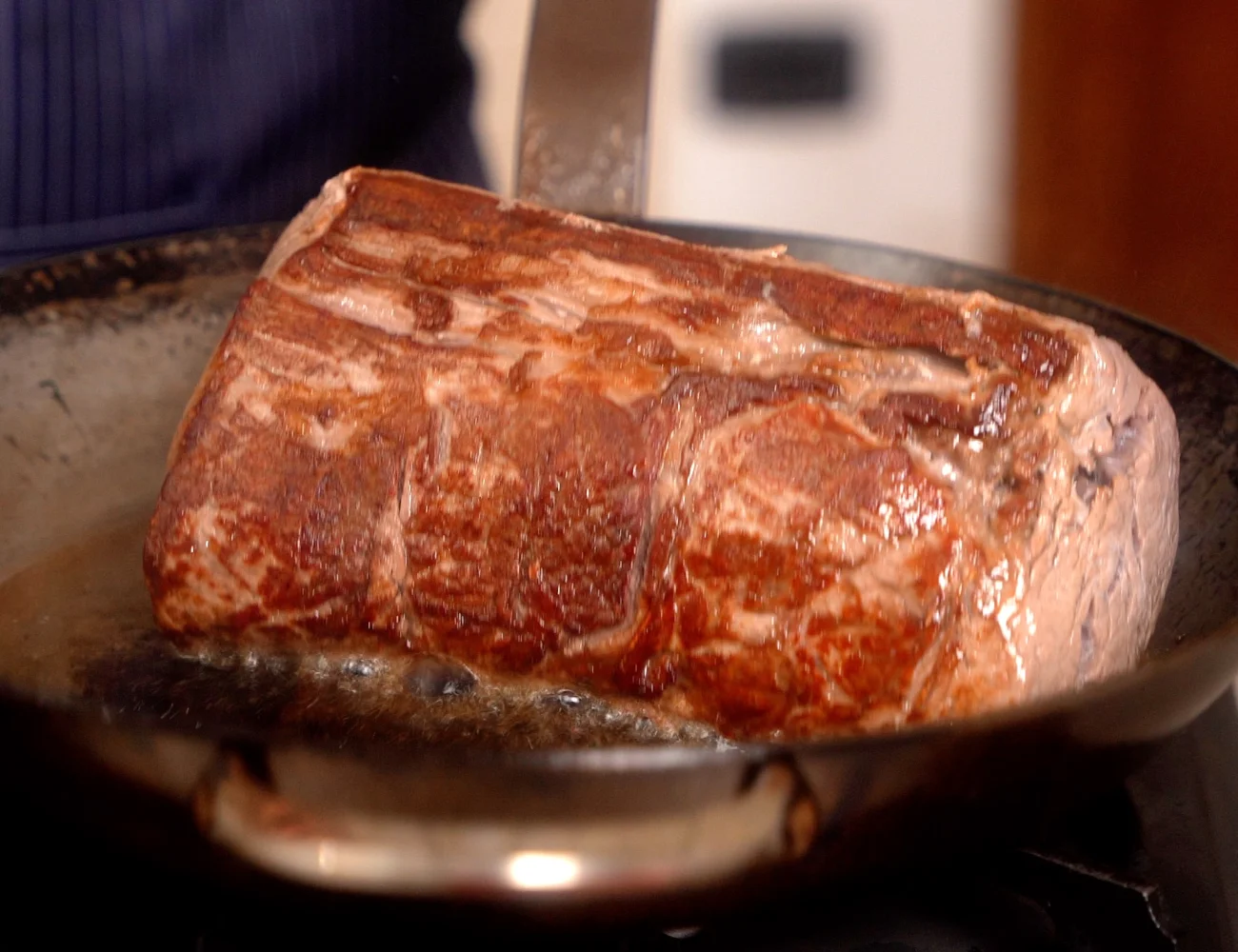
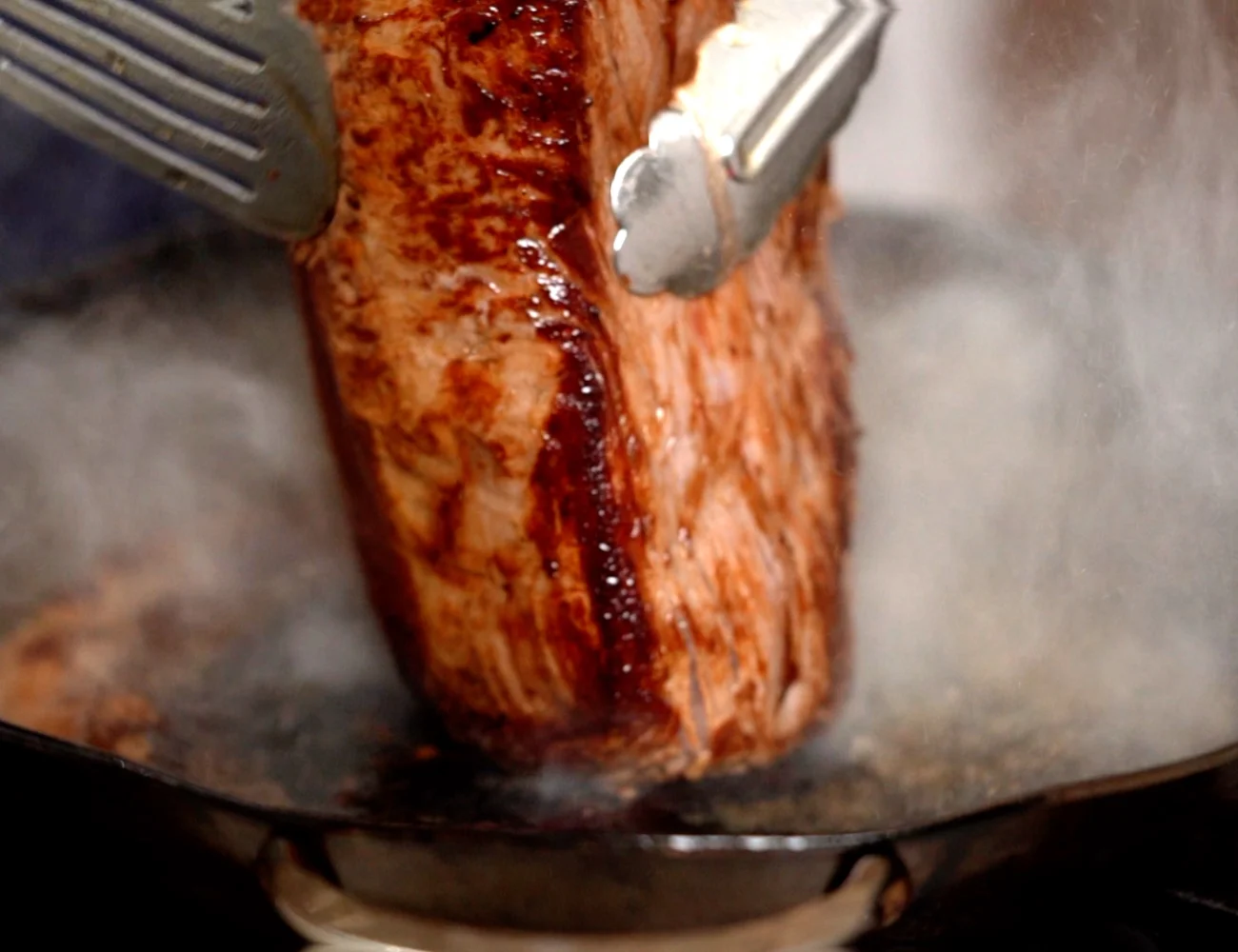
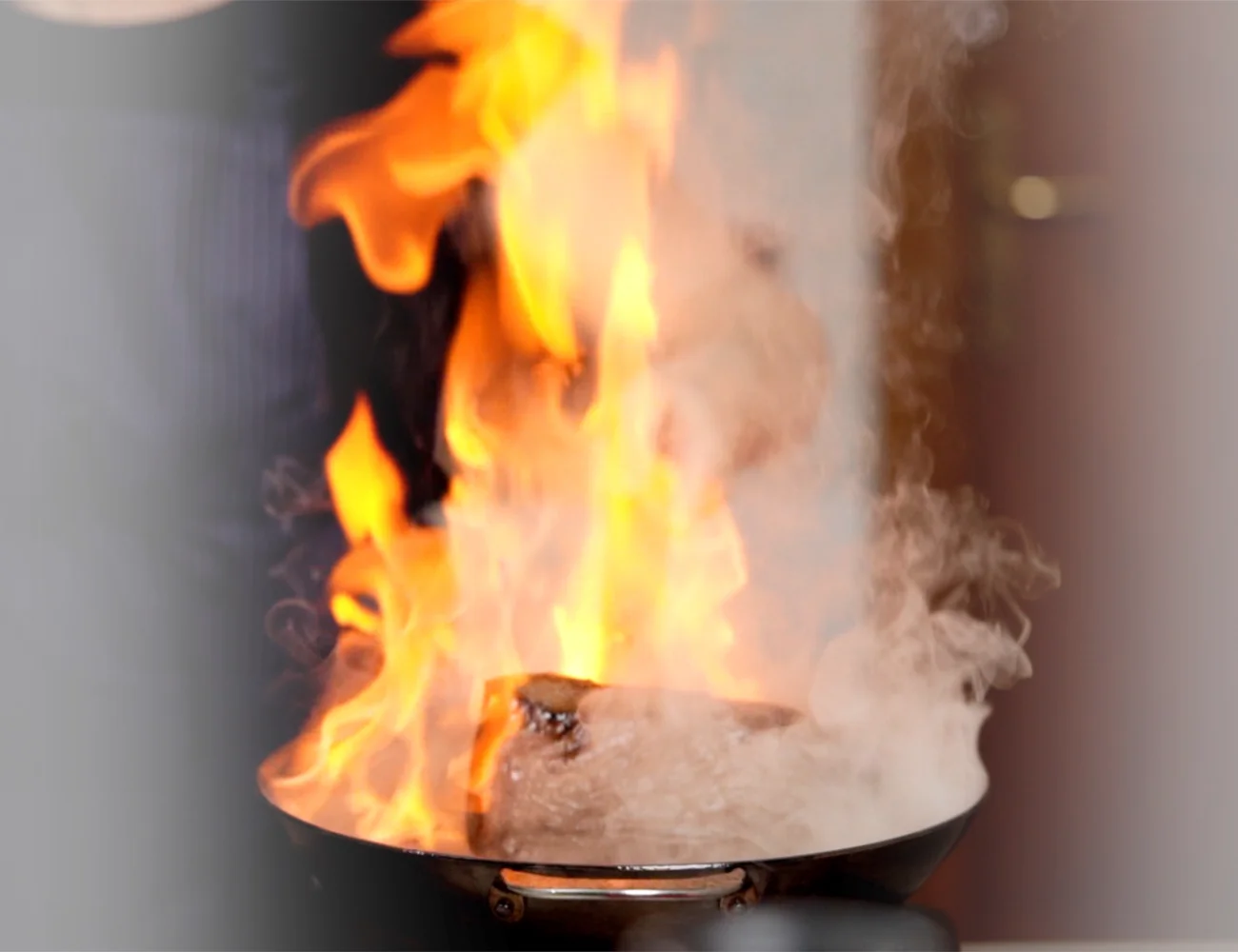
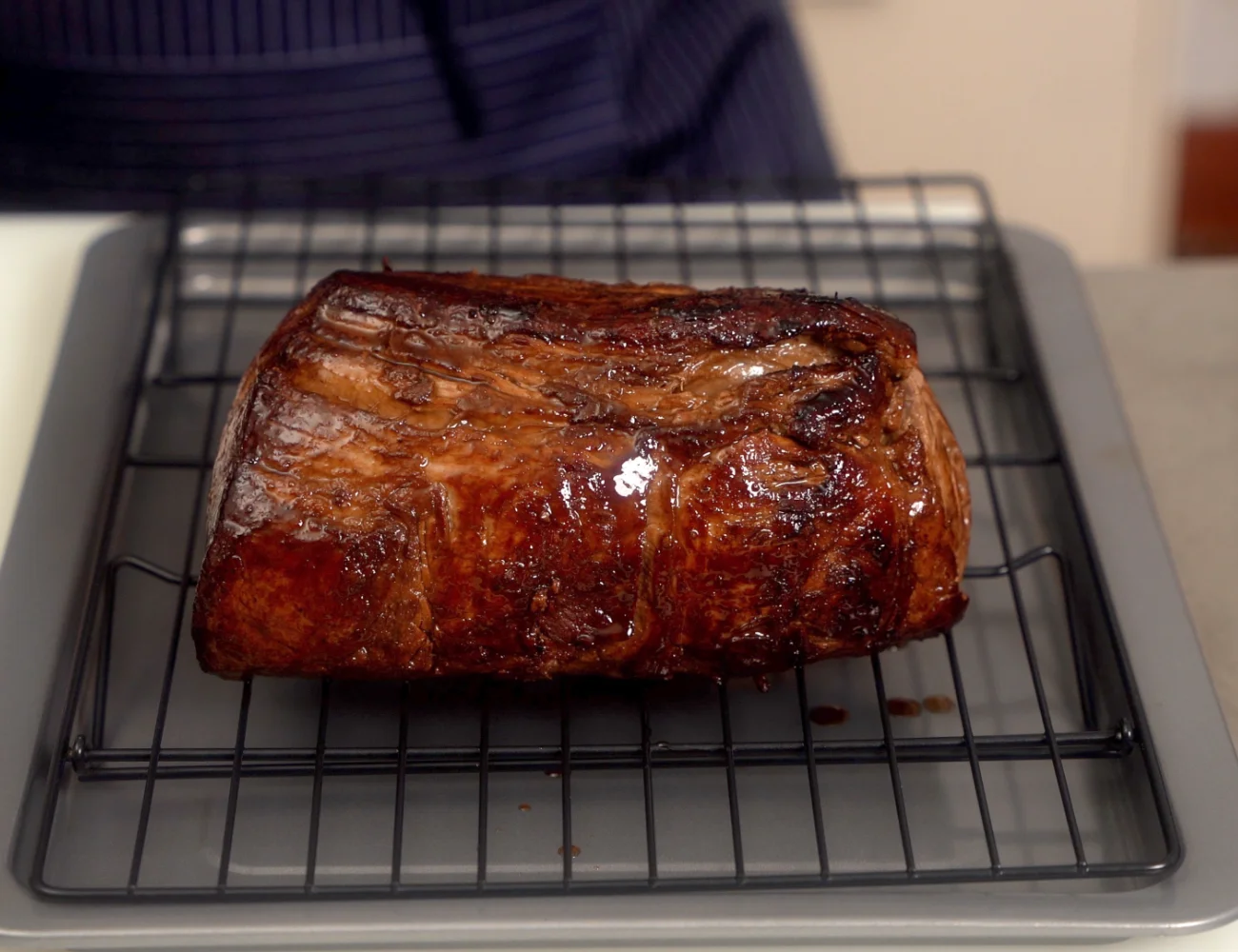
Paste (Pâté or Duxelles)
Pâté
A pâté is simply a paste made from a variety of meats and spices. Sometimes foie gras is used for the Beef Wellington. Foie gras is made from the fattened liver of geese. At PIATTO™ Recipes, we prefer a mushroom duxelles.
Mushroom Duxelles
Duxelles is a word in French cuisine. It refers to a mix of minced mushrooms combined with shallots and herbs (and butter) and reduced to a chunky paste consistency.
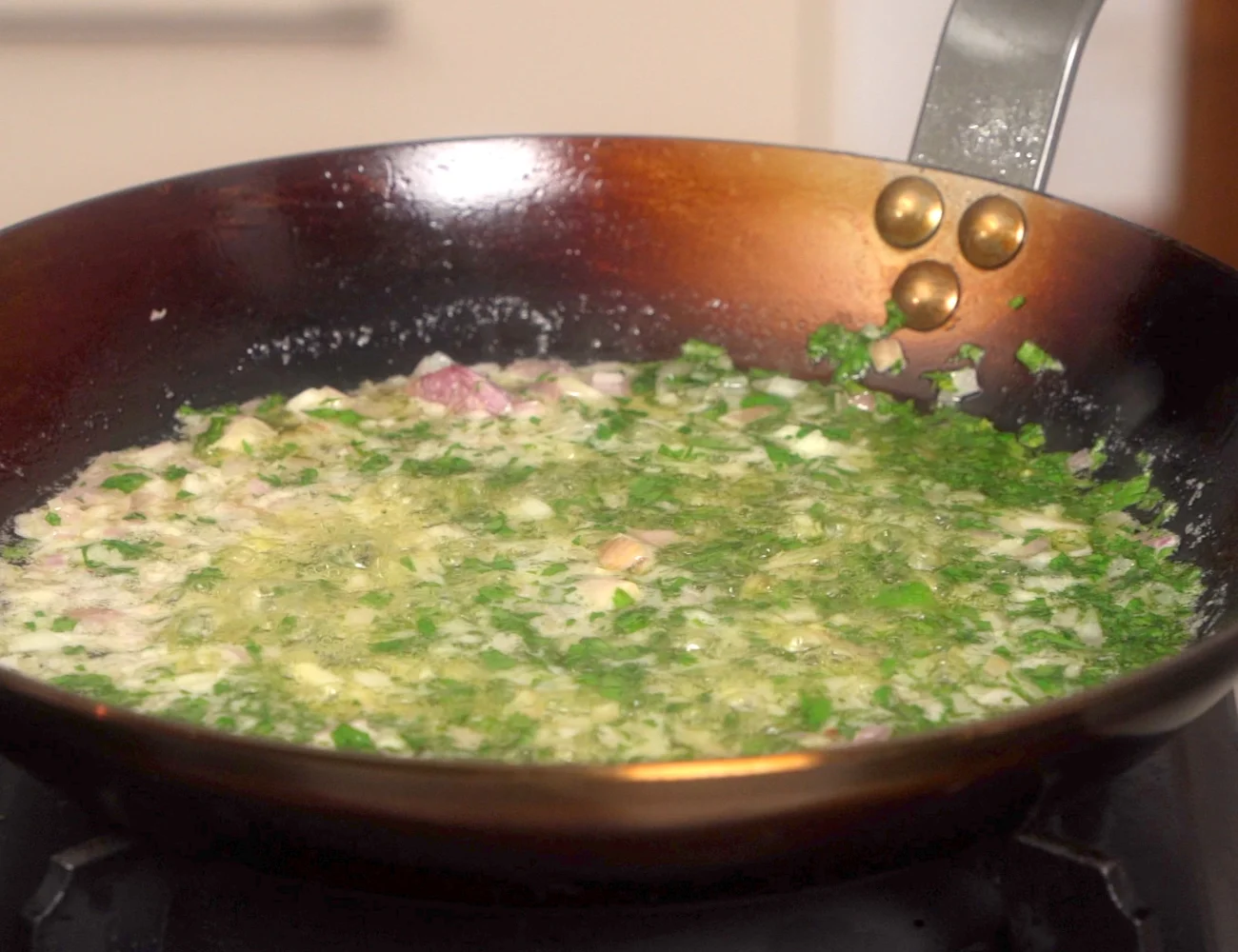
What Mushrooms to Choose
A variety of mushrooms can be used to make the duxelles. We recommend that you choose a base mushroom that is more economical (like button or champignon mushrooms). Then, add a handful of more flavorful mushrooms to that—like porcini or truffle.
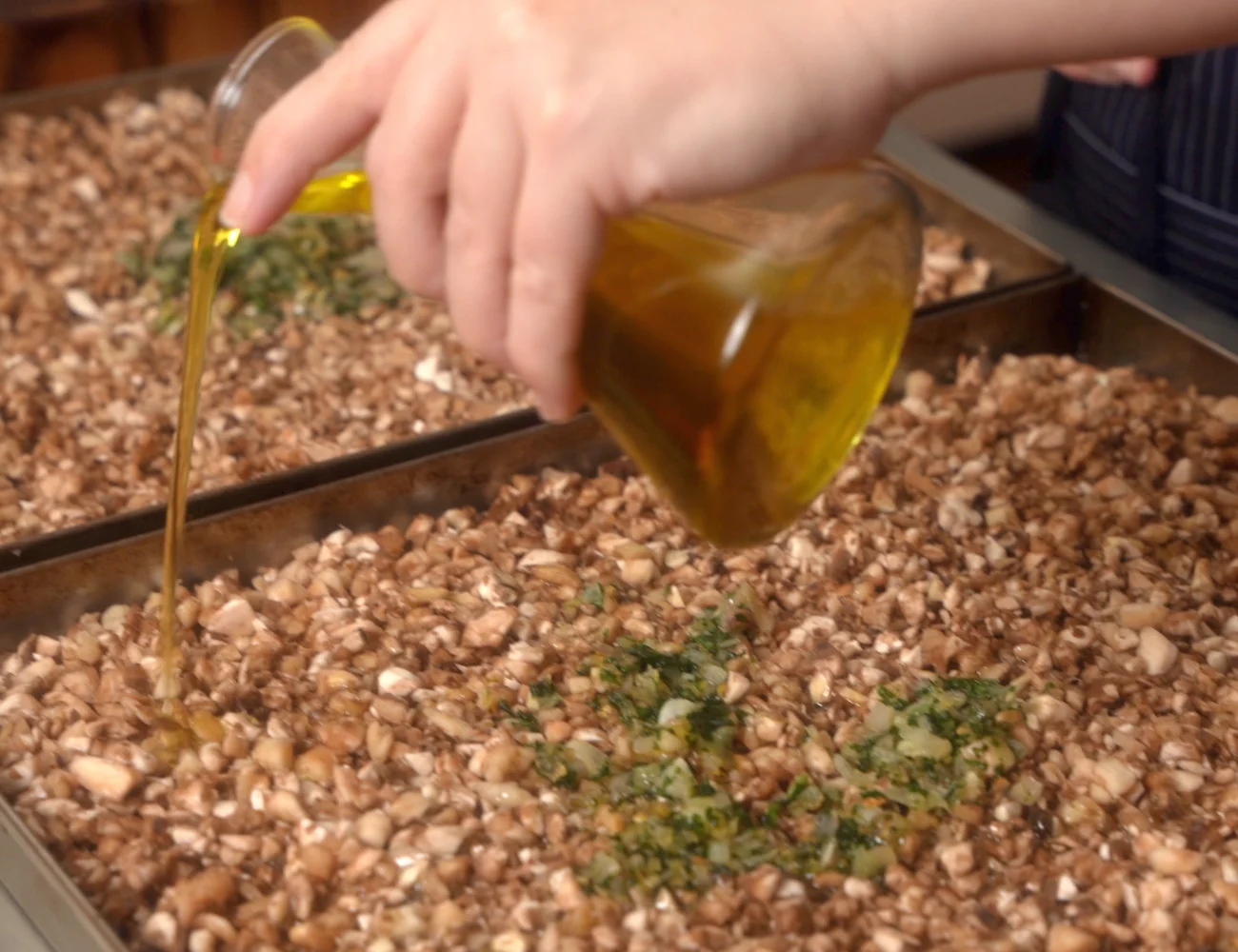
A duxelles should be pretty dry before it is added to our Beef Wellington. This is because we don’t want too much liquid in our Beef Wellington. Why? If the mushrooms aren’t dry enough, then they will release water as the Beef Wellington is cooking. This can result in the mushrooms shrinking and leaving gaps between the meat and the crêpe and puff pastry—the Beef Wellington won’t be tight when you cut it. Also, you risk a ‘soggy bottom’ if there is too much juice and that juice leaks into the puff pastry.
For all these reasons, we like to cook our mushrooms with the shallot sauté in the oven on fan at 350°F (180°C) until the mushrooms have dried out. They will still be moist, but they will have lost much of the water which can cause problems for us later.
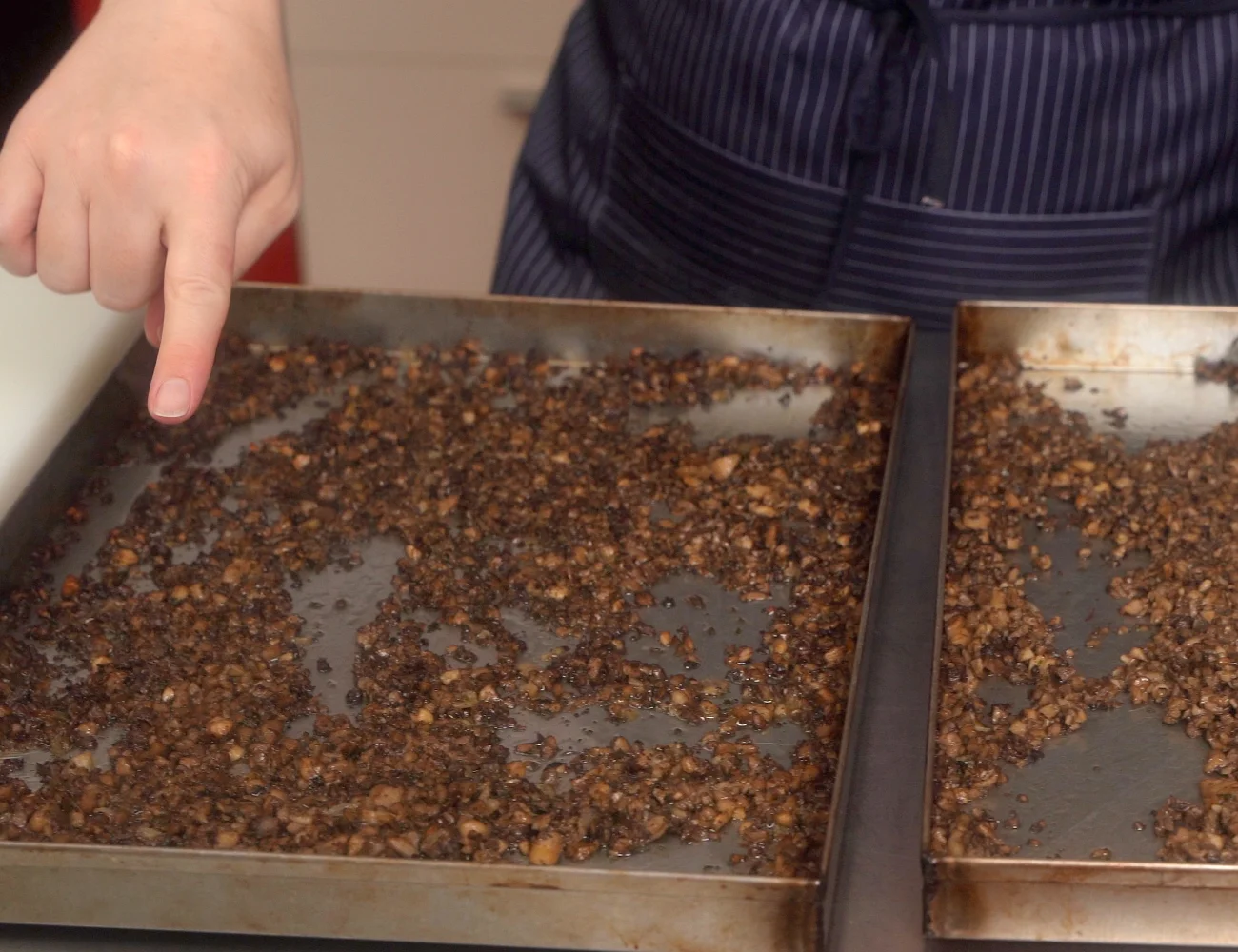
In this PIATTO™ recipe, we are in fact adding a bit of truffle sauce to our final duxelles (made with champignon mushrooms) in order to give it a boost of flavor—and make it a bit more Italian! Here we used Tartufo Bianco d’Alba (affiliate link).
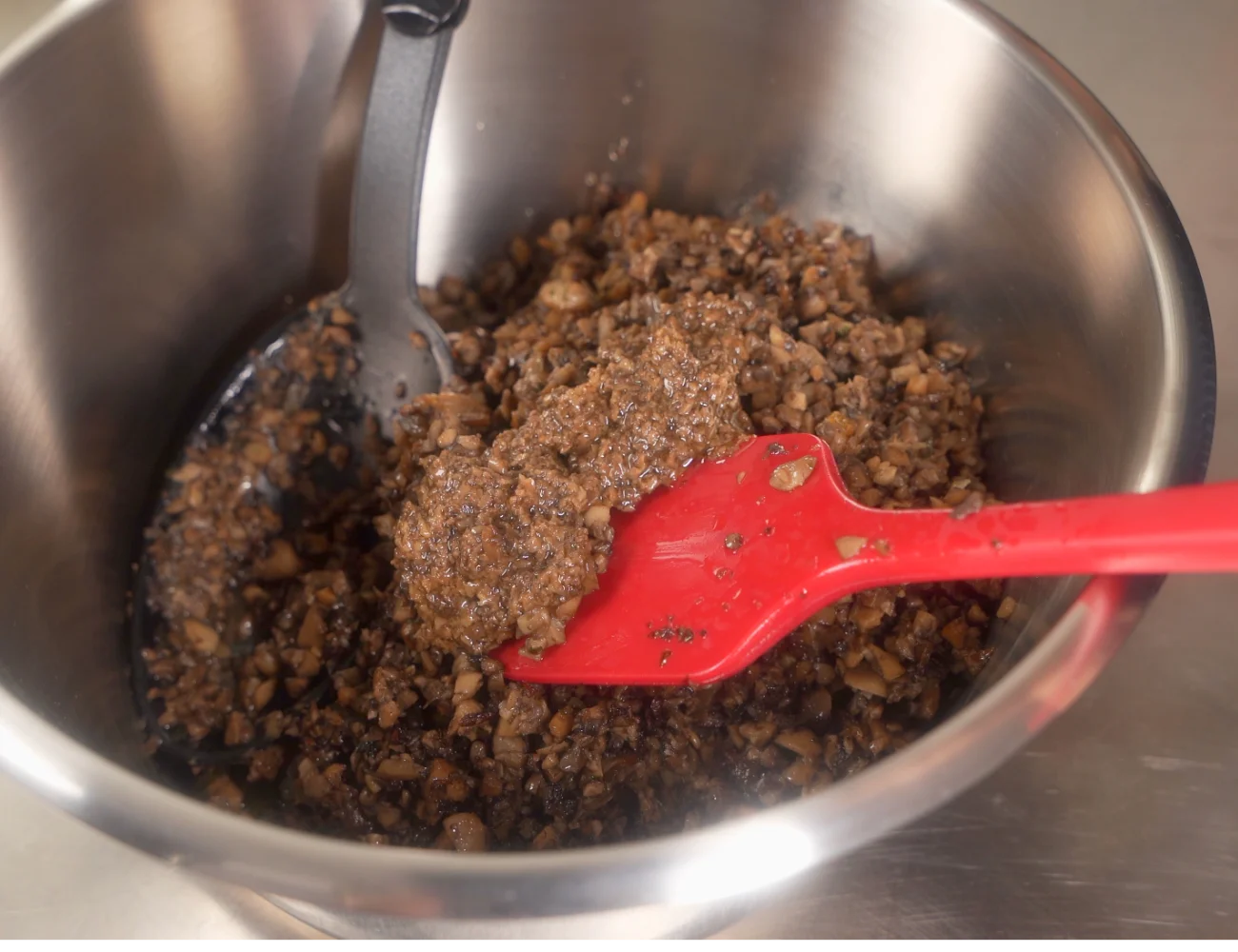
Prosciutto di Parma -Parma Ham (Optional)
One of the biggest challenges for beginners making this dish is avoiding the dreaded ‘soggy bottom.’ In British lingo, the ‘soggy bottom’ refers to pastry that becomes soft (instead of crispy). This is caused when the juices from whatever is cooking inside it have soaked through to the pastry.
To avoid this problem, many foolproof Beef Wellington recipes like ours suggest adding a layer of sweet prosciutto and a crêpe between the beef and mushrooms and the puff pastry. These ingredients not only add amazing flavor, but act as a shield to defend the puff pastry from any juices released during the cooking process.
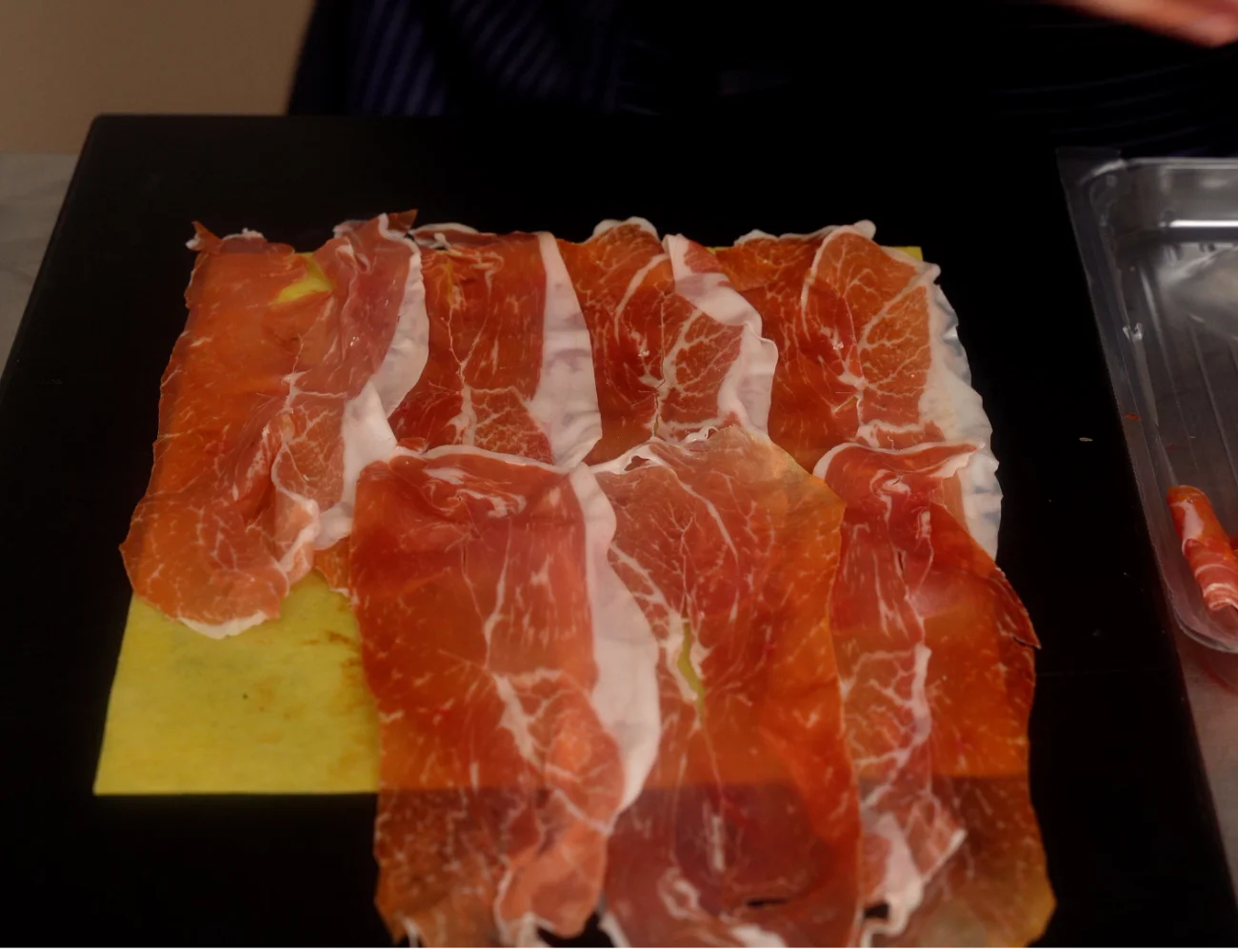
Crêpe (Optional)
Everyone knows that a shield only works if it is free of cracks and holes. The same is true for our crêpe shield!
For this reason, we recommend making the crêpe for this Beef Wellington recipe in a rather unconventional way. Instead of making large round crêpes in a skillet (traditional) and then piecing them together to cover your Wellington, we suggest making a large rectangular crêpe—in the oven!
Believe it or not, making crêpes in this way is actually easier than making them in the pan. There is no need to flip the crêpe, which is what many beginners find daunting about making crêpes.
Instead, pre-heat a large nonstick baking tray in an oven at 400°F (200°C ) for 10 minutes. Then, remove the tray and pour in a thin layer of crêpe batter (very thin!). Then, put the tray back into the oven until the edges of the crêpe begin to peel away from the tray.
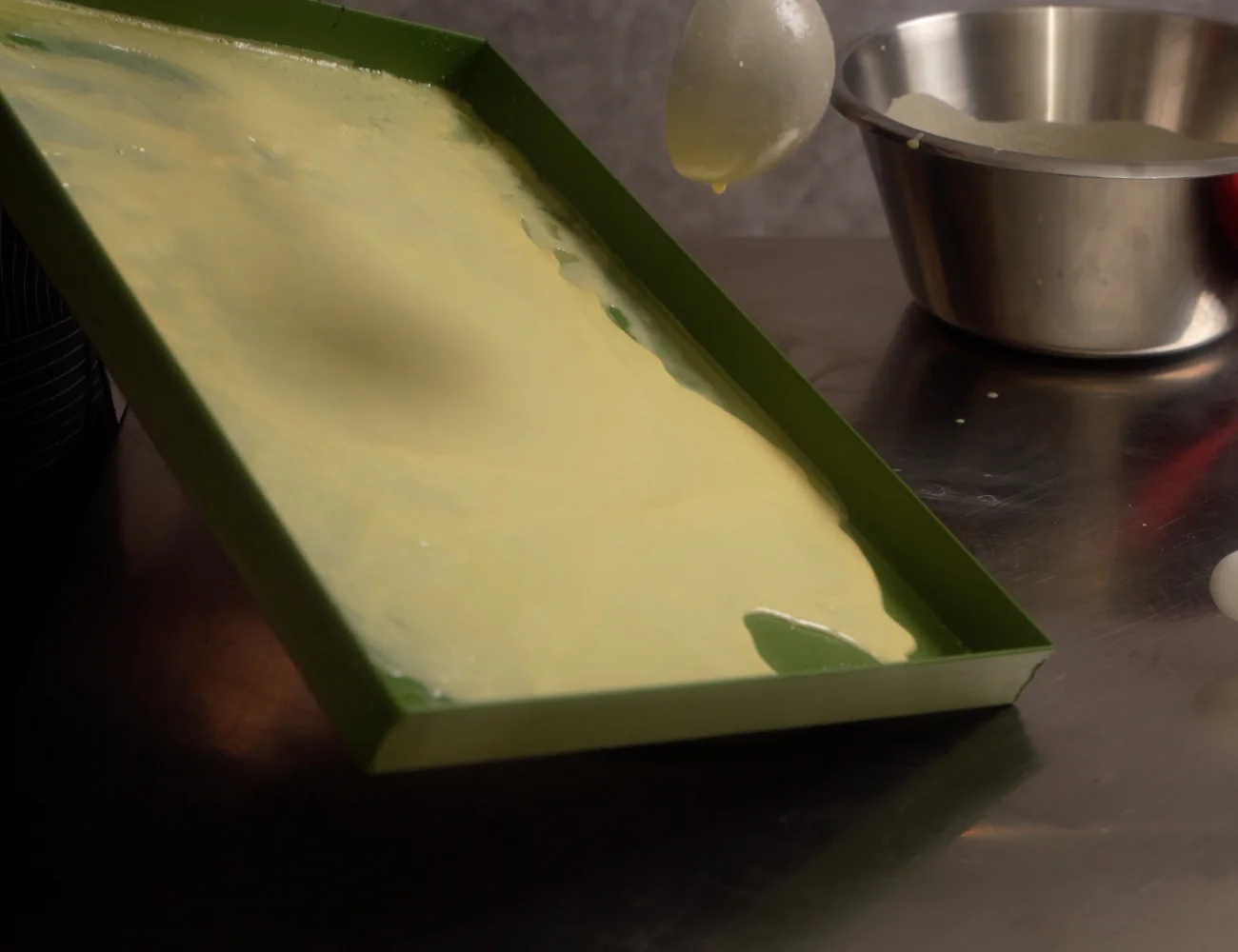
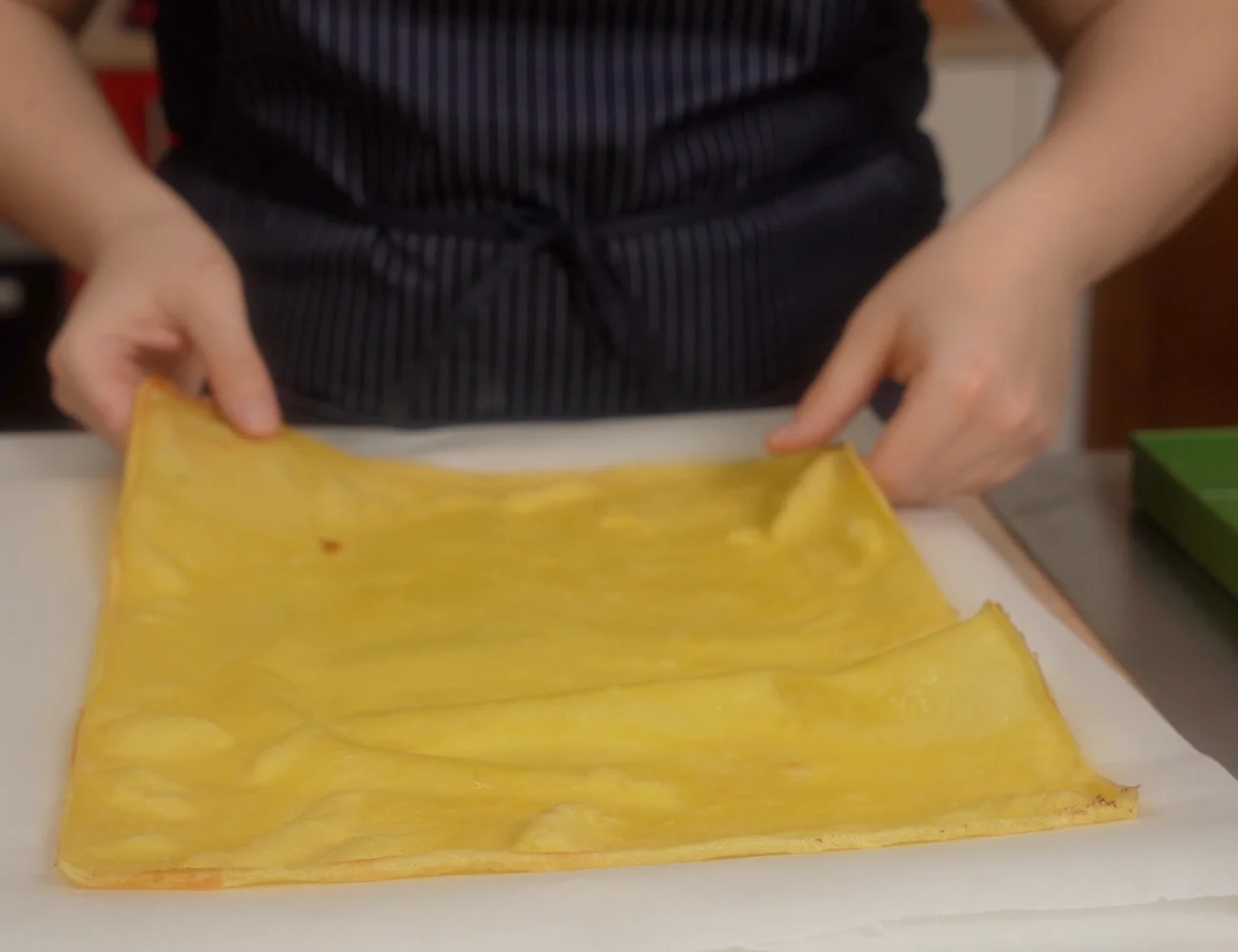
Because the oven can cook the crêpe on the top and bottom at the same time, there is no need to flip! This same strategy can be used for making crêpes for cannelloni as well. It’s faster and easier than preparing a bunch of smaller crêpes in a pan.
Puff Pastry
The Beef Wellington (already wrapped in the other ingredients and the crêpe) needs to be finally wrapped in a puff pastry! Notice that we’ve made little holes in our pastry. This allows steam to escape and keeps the puff to a reasonable size—which is what we want in a Beef Wellington!
We highly recommend you make this puff pastry from scratch the day before (recipe coming soon), as we do. Why? You can make the puff pastry large so that there is no need to piece together smaller sizes to wrap a whole tenderloin.
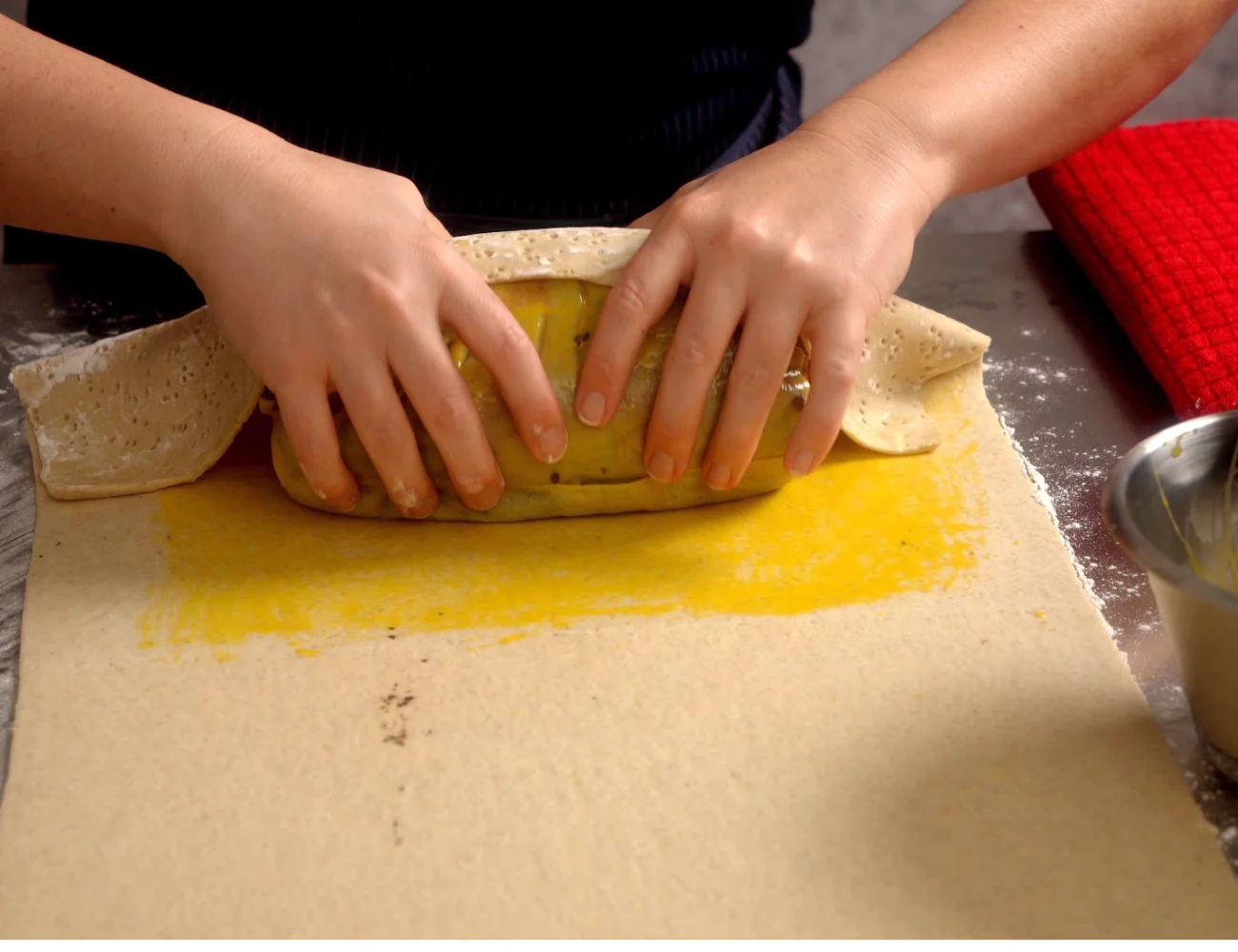
Buy the puff pastry in the supermarket if you must, but we advise against it for two reasons. First of all, many commercial puff pastries come in sizes too small to wrap an entire Beef Wellington with one piece. Secondly, many commercial puff pastry products contain palm oil and other sketchy ingredients rather than the classic butter.
Ask a Pastry Shop!
What’s better than buying the puff pastry in a supermarket? Just ask your favorite pastry shop if you can buy a large piece of puff pastry off of them. Pastry shops have to crank out large quantities of puff pastry for various goodies that they make daily. They will probably be willing to sell you a piece. This is what we do in Italy when we don’t have the time to make the puff pastry from scratch.
The puff pastry needs to be covered with a thin layer of egg wash (made from yolks and heavy cream) before it is wrapped around the crêpe-wrapped beef. We’ll explain this in more detail in the next section.
How to Make Beef Wellington
Once all of the ingredients have been prepared in advance, assembling the Beef Wellington is very easy.
Cover the Crêpe with Prosciutto and Duxelles
Start with one large rectangular crêpe that is 40cm x 30cm (16″ x 12″) in size. Cover the crêpe with thin slices of sweet prosciutto (Prosciutto di Parma, sometimes called ‘Parma Ham‘).
Then, cover the prosciutto with the mushroom duxelles.
Wrap the Filet in the Crêpe
Place the filet (salted, and after it has rested for 2 hours) on top of the duxelles. Then, tightly wrap it in the crêpe. Let the whole thing rest for at least 1/2 an hour.
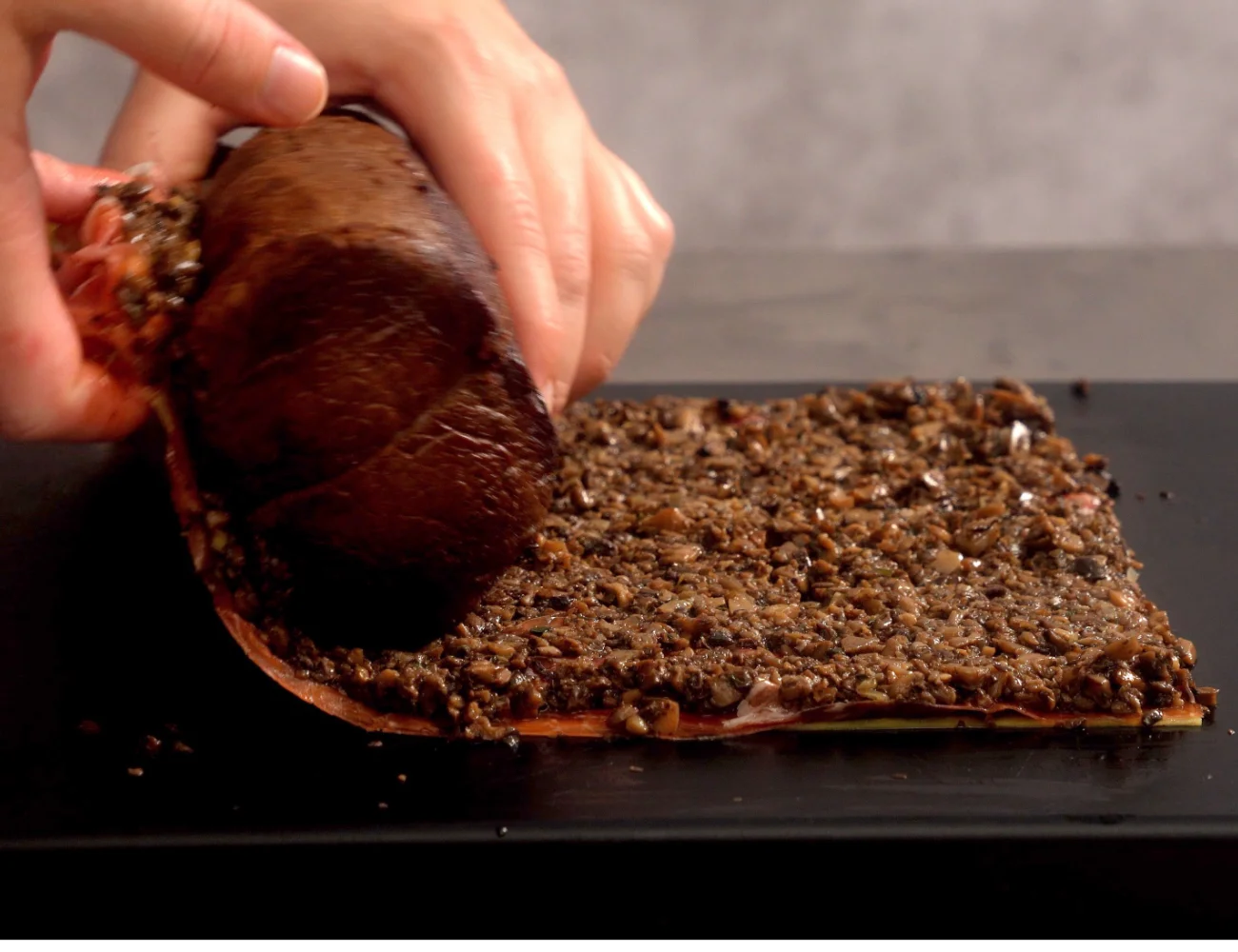

Once our Beef Wellington is wrapped, we want to make the wrap tighter with plastic wrap. See our video for the best way to make a tight wrap around the whole thing with plastic!
Be sure the seams of the crêpe hug together tightly. To play safe, you can leave a tiny bit of the crêpe uncovered by duxelles so that you can overlap the crêpe with the other side a bit to get a good seal.
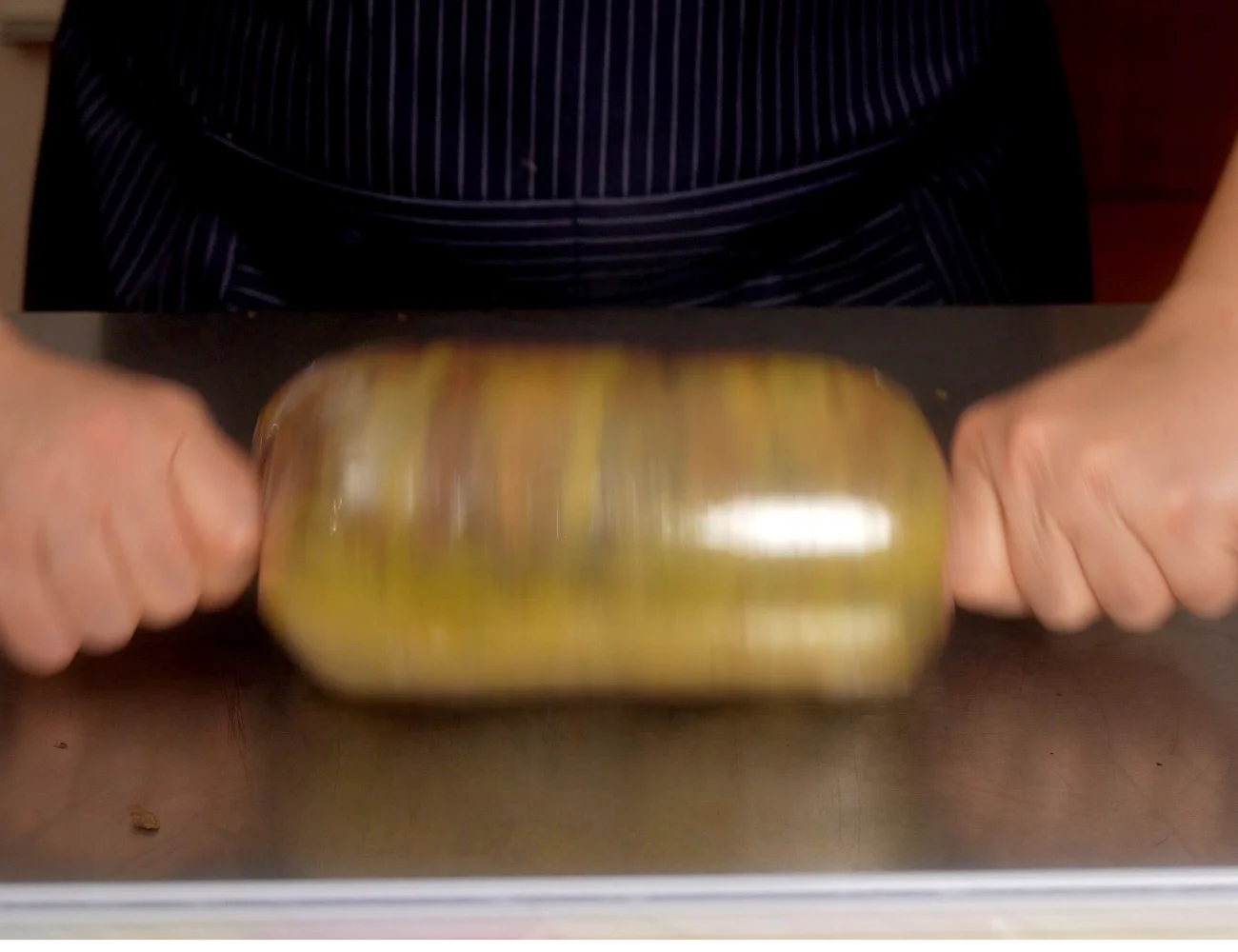

Wrap Everything in Puff Pastry
Once the Beef Wellington has rested another 1/2 hour, it is ready to be wrapped in cold puff pastry. Again, we need two large pieces here: roughly 40cm x 30cm (16″ x 12″) each.
So, if you are buying pieces of puff pastry from a pastry shop, ask for pieces at least this large.
Brush a thin layer of egg wash (made of yolks and cream) over the inside of the puff pastry. Wrap the crêpe-covered filet tightly in the pastry as we show below:



After the wrap, trim the puff pastry down. Leave enough puff pastry on the sides to seal it with a fork. Then fold the sides under.
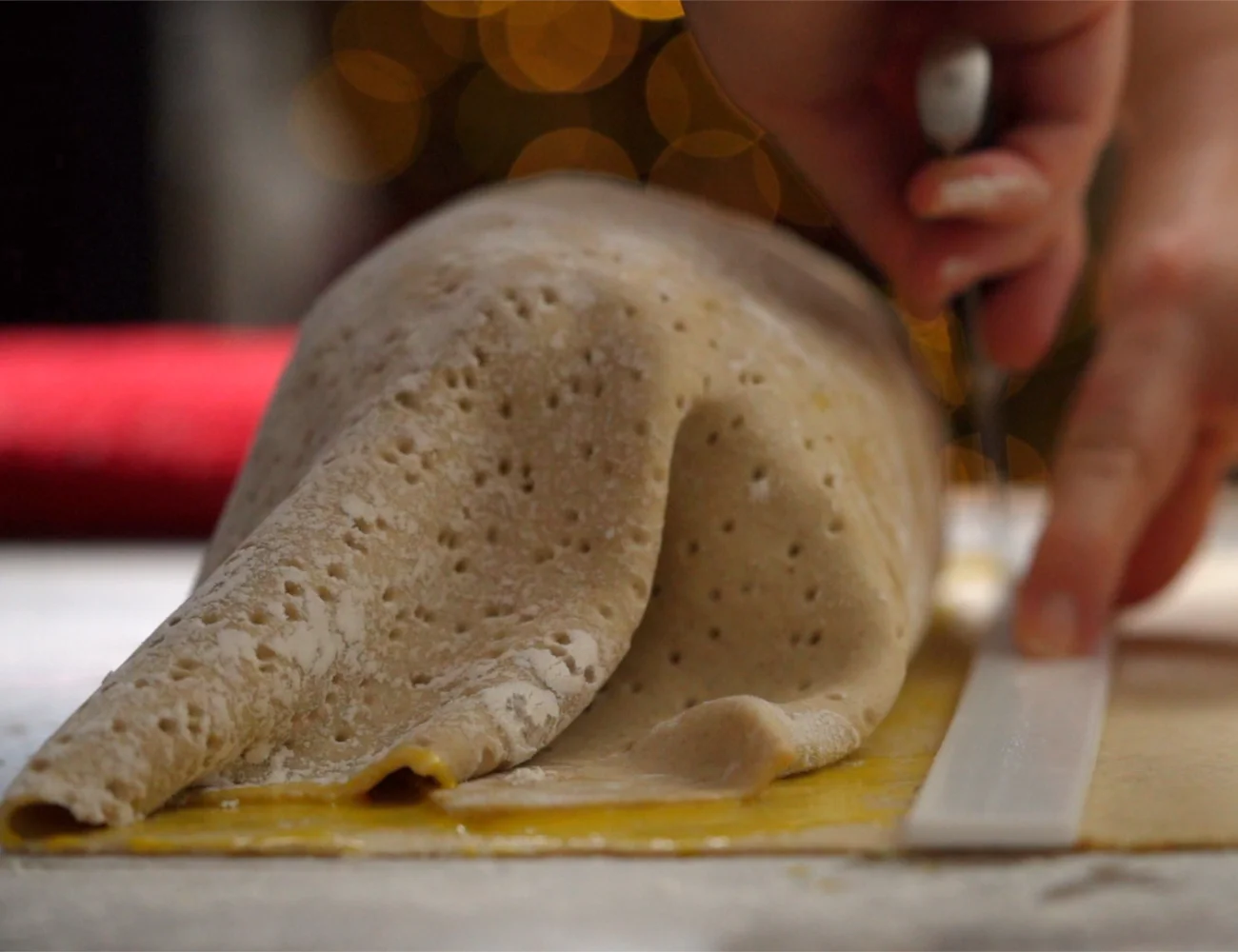

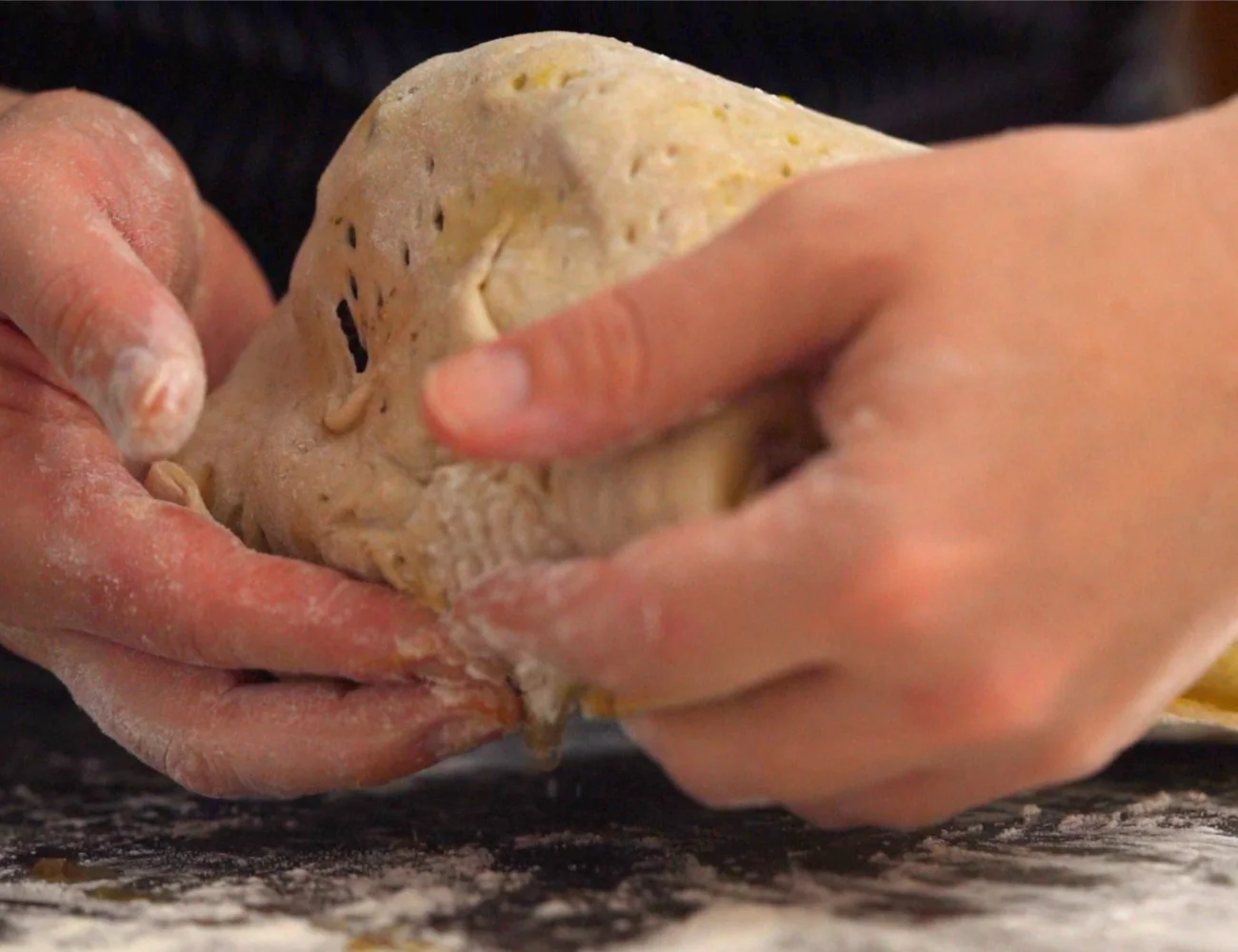

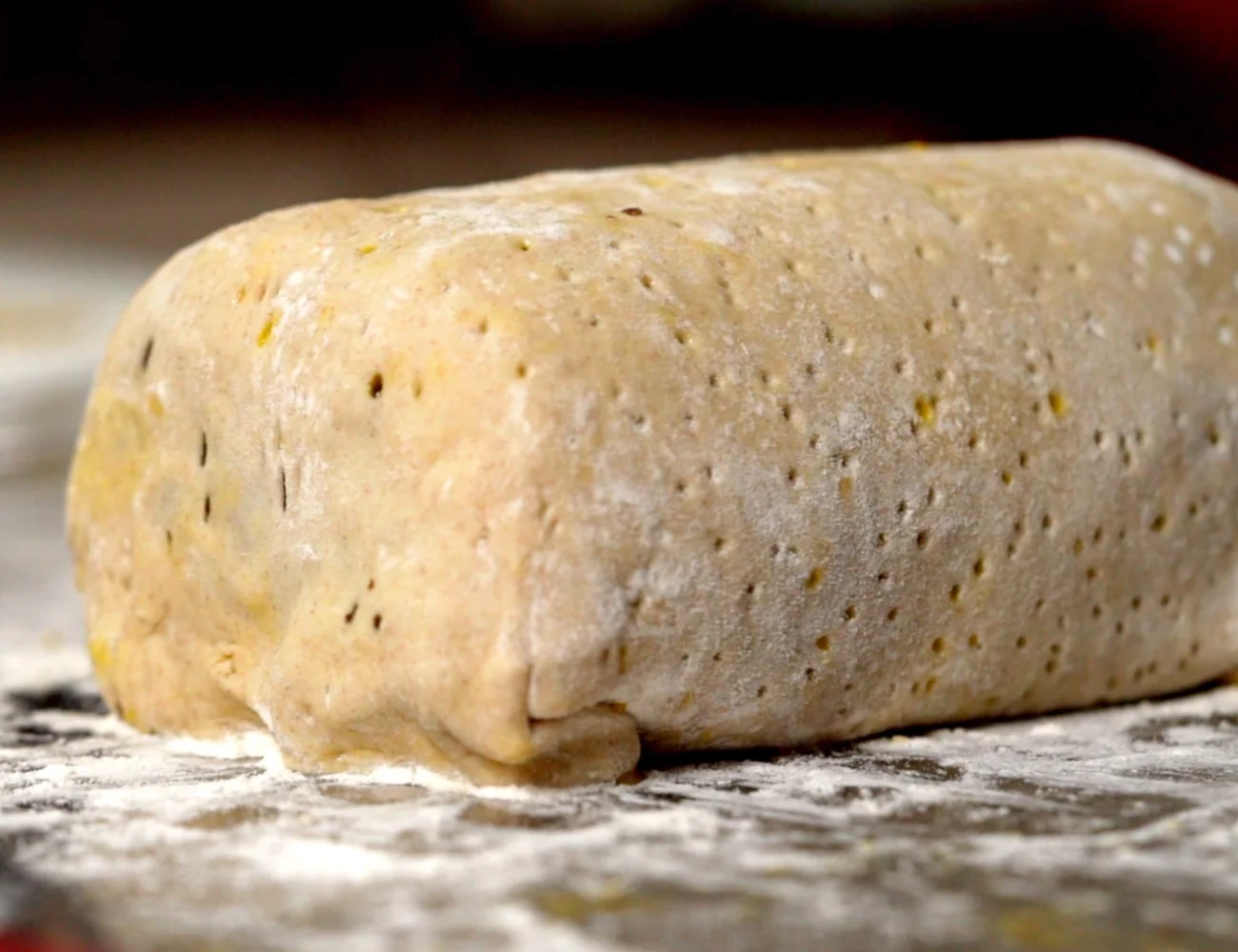

Now, we cover the entire outside of the Beef Wellington with egg wash.
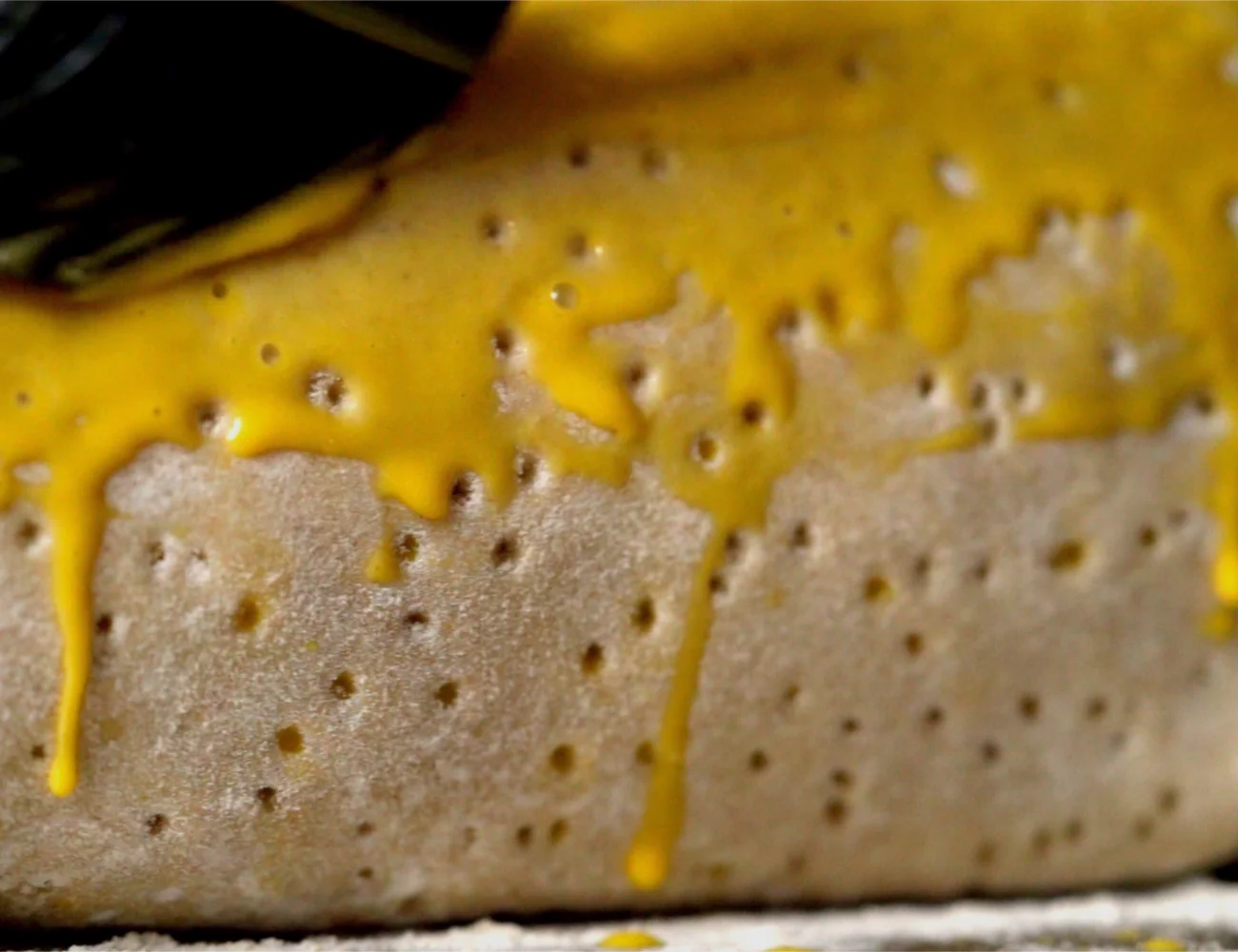

Final Puff Pastry Decoration!
Traditionally, the Beef Wellington has a puff pastry decoration on the outside. We like to go with a classic lattice shape, which we use this lattice roller cutter to produce (affiliate link).
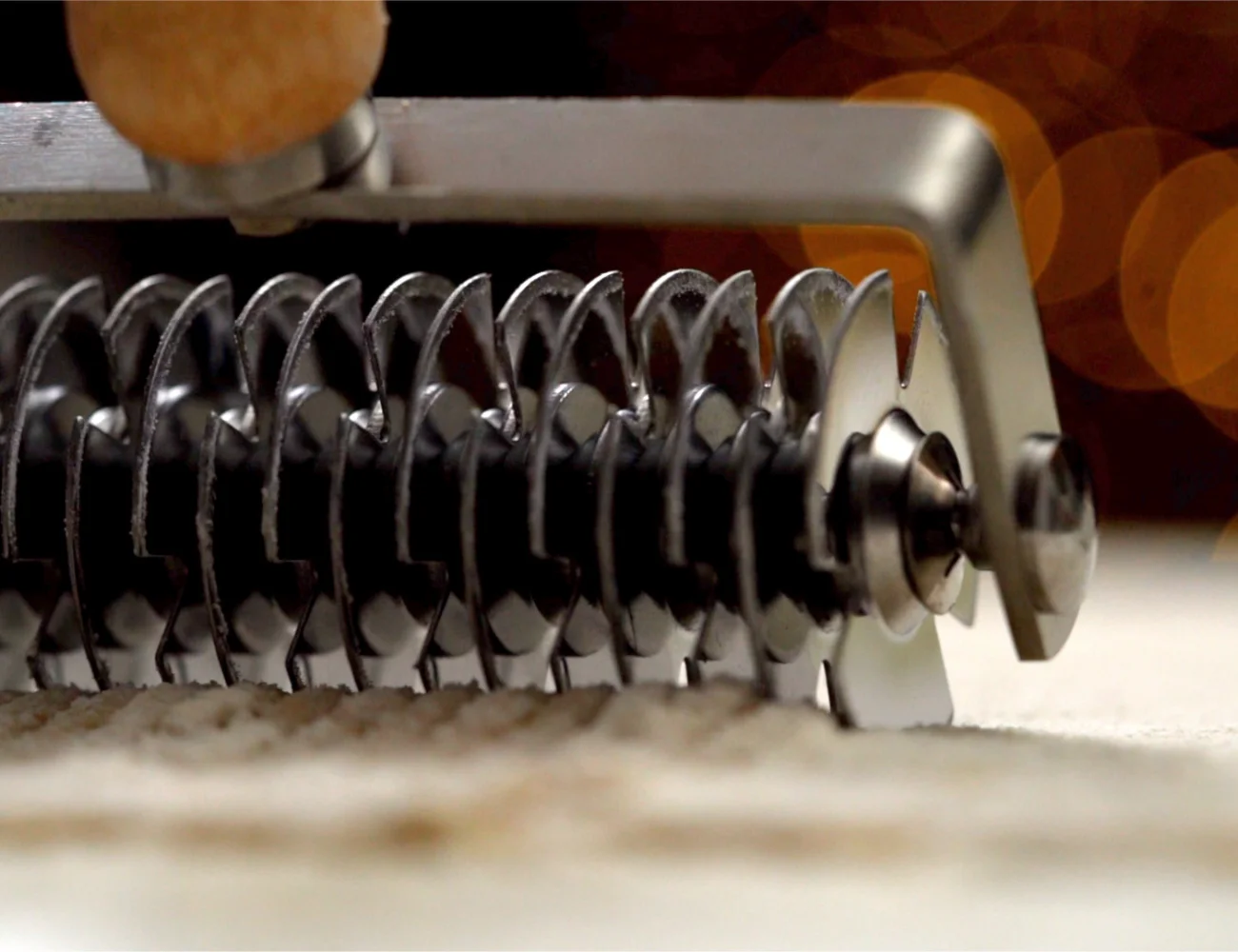

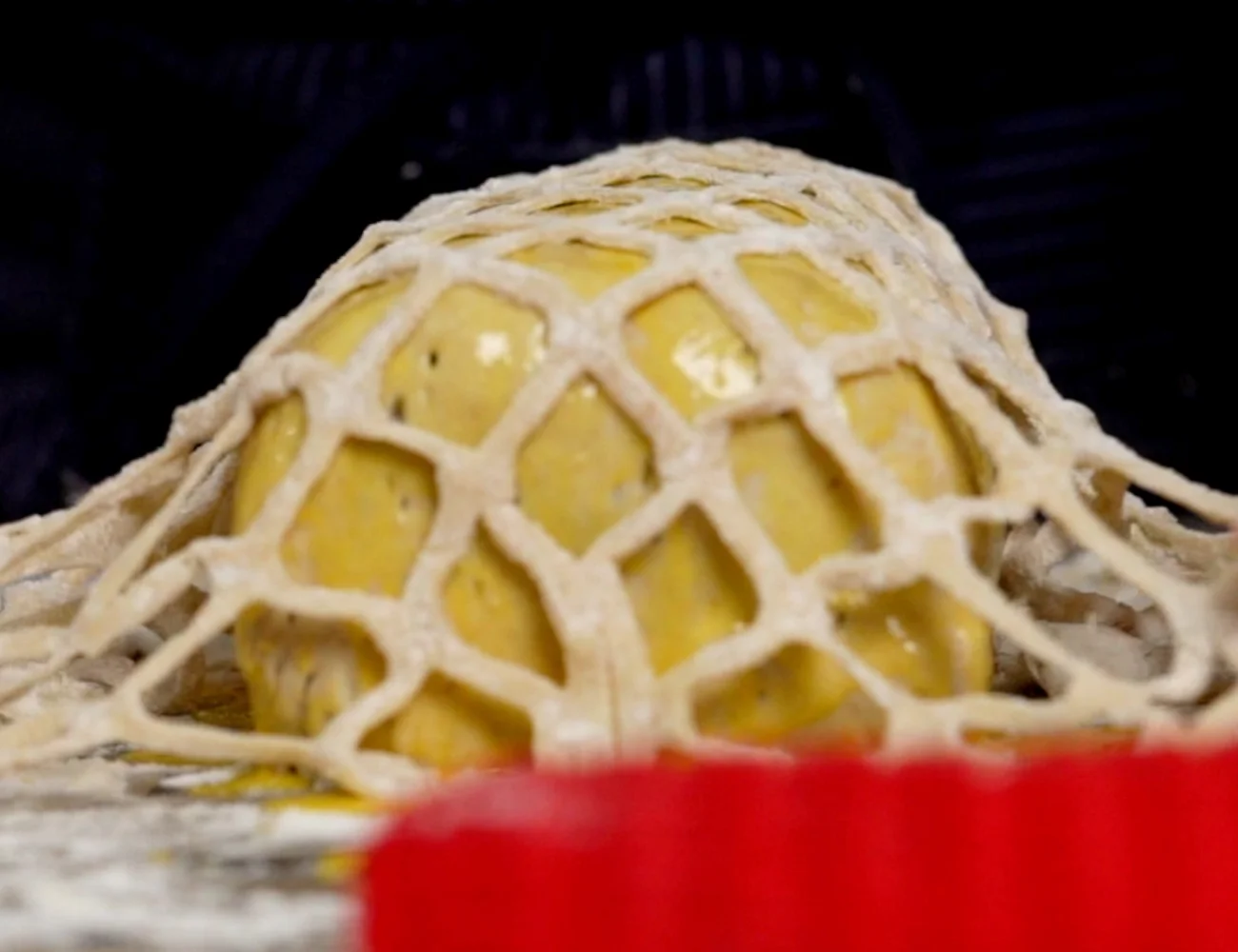

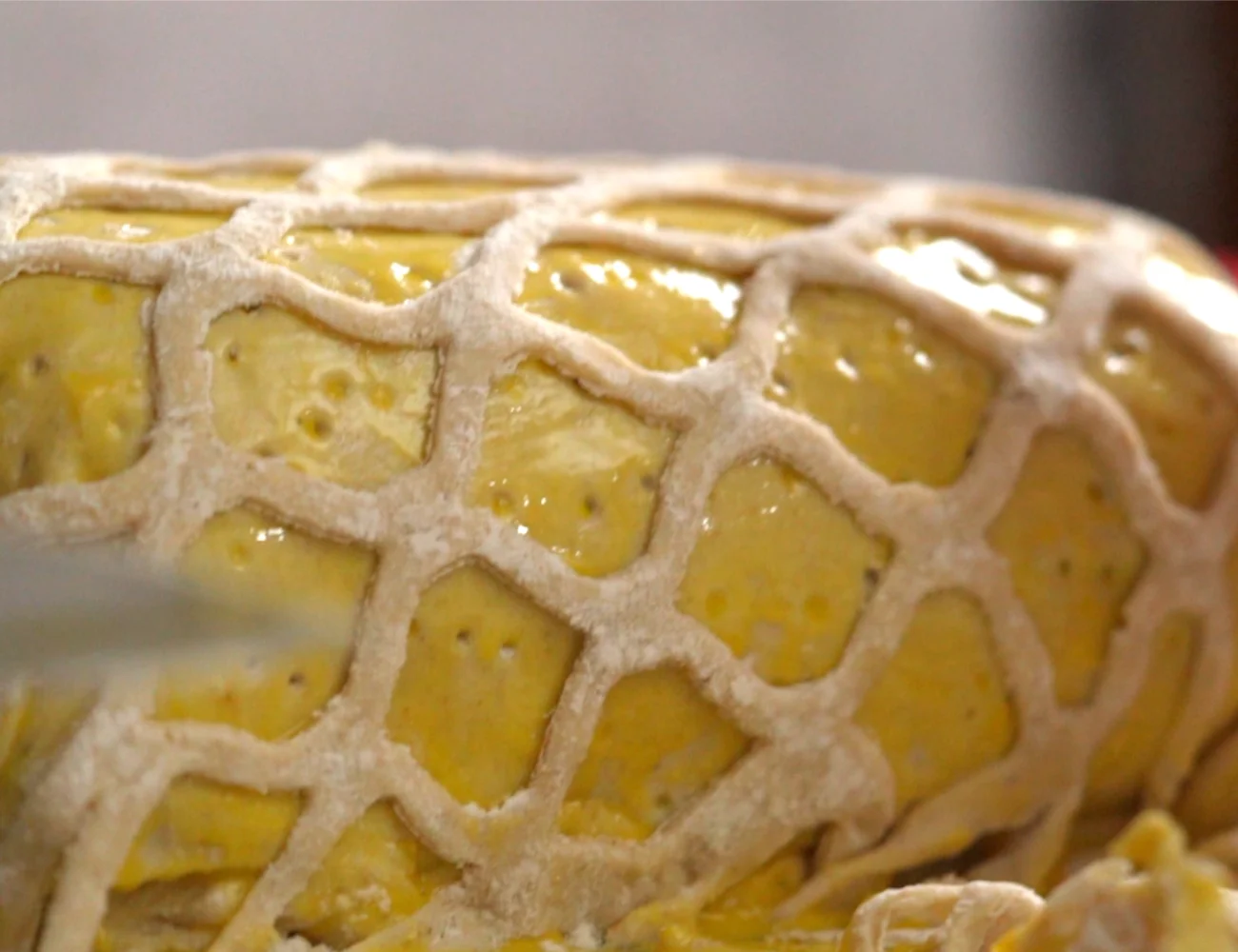

And finally, we trim the decoration to size and add egg wash to that as well!
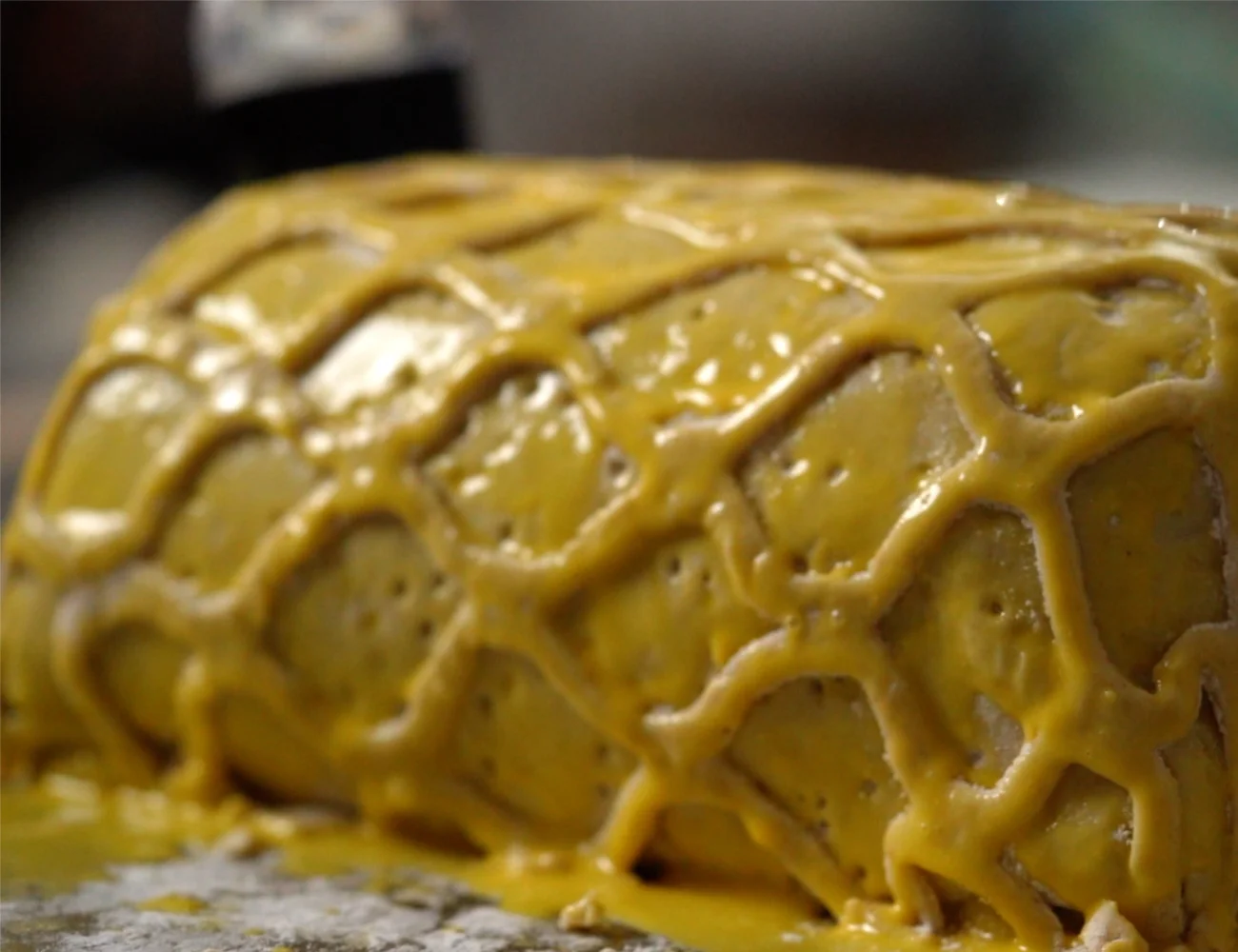

Baking the Beef Wellington
Bake the Beef Wellington on a baking tray at 400° F (200° C) for 20 – 25 minutes. This should result in a medium-rare cook.
However, you’ll need to judge doneness for yourself by eye— or better yet, with a thermometer!
The puffed pastry should be golden. The ideal internal temperature of the meat should be around 118°F (48° C) for a medium-rare beef.
Tip: Cook the Beef Wellington medium-rare for those who like that. Then, you can always pass slices back into the oven for those who prefer a less rare dish.
Note: The FDA recommends that beef be cooked to an internal temperature of 145° F (63° C) with a 3-minute rest to avoid the risk of food-borne illness coming from undercooked meat.
Here are a few more looks at our Beef Wellington!
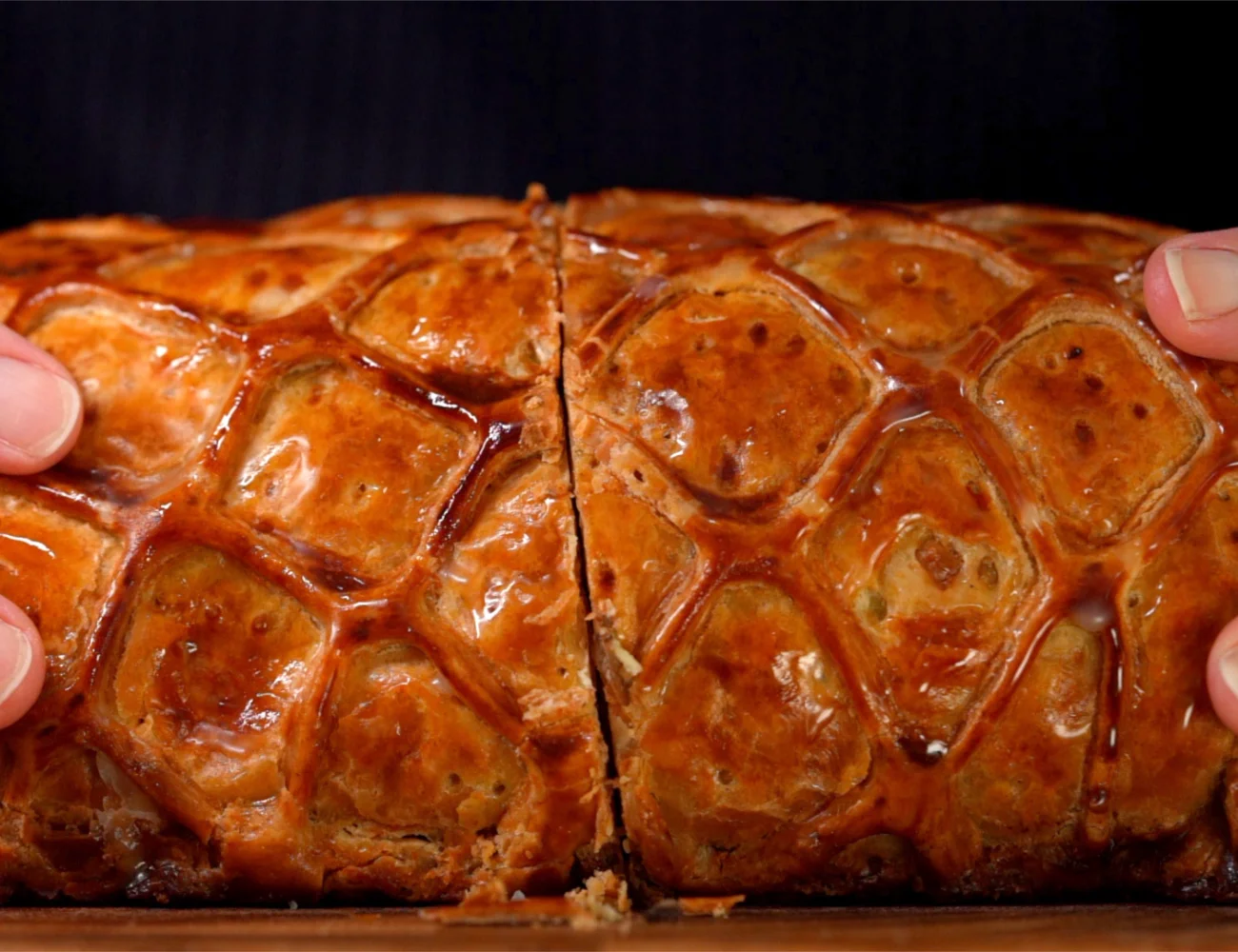

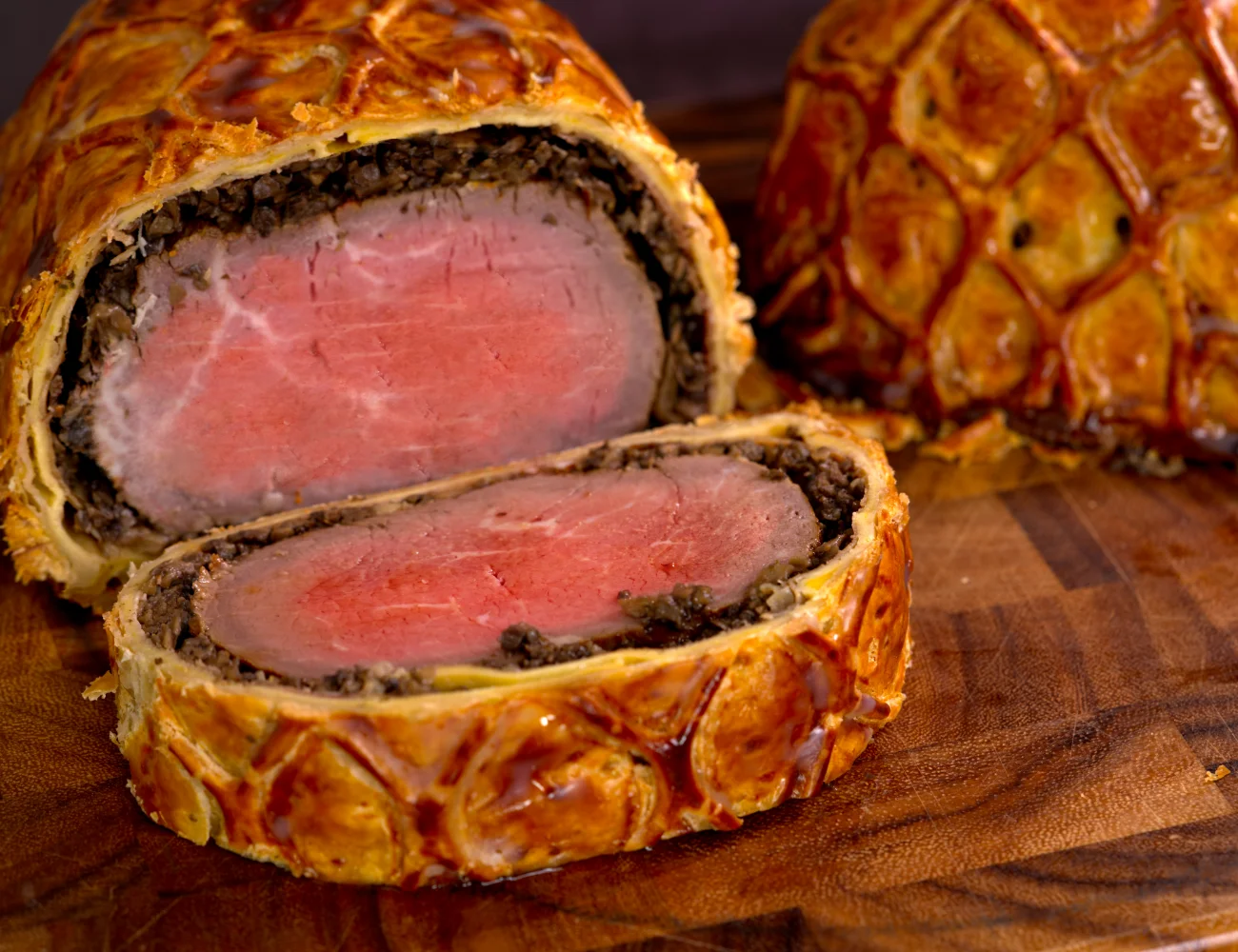

As an Amazon Associate, we earn from qualifying purchases. This means at no extra cost to you, PIATTO may earn a small commission if you click the links and make a qualifying purchase.
Foolproof Beef Wellington Recipe
Equipment
- 1 skillet or pan for searing the filet
- plastic wrap
- 1 baking tray
- 1 mixing bowl
- 1 lattice roller cutter (for decoration) OPTIONAL
Ingredients
- 2.2 lb beef filet (fillet) after cleaned, cut to size
- 6 oz sweet prosciutto 'Prosciutto di Parma' (thin slices)
- 2 oz truffle sauce OPTIONAL – to add a flavor boost to the mushrooms
- 2 tbsp clarified butter SEE OUR RECIPE TO MAKE IT AT HOME!
- 2 tbsp cognac OPTIONAL – to deglaze
- 2 sheets puff pastry around 40cm x 30cm (16″ x 12″) in size
- 2 yolks eggs for pastry egg wash
- 1 tbsp heavy cream for pastry egg wash
- fine salt as needed to salt the beef filet
Mushroom 'Duxelles'
- 2.2 lb mixed mushrooms button or champignon, or a mix- minced
- 3 shallots minced
- 1 handful parsley minced
- 2 tbsp butter or clarified butter
- olive oil as needed
Crêpes —for two rectangular in size— 40cm x 30cm (16″ x 12″)
- 1 cup all-purpose flour
- 2 whole eggs
- 1 ¼ cup milk preferably, whole milk
- ½ tbsp fine salt
- 2 tbsp fine granulated sugar
- 2 tbsp butter melted
Instructions
Make the Puff Pastry (OPTIONAL)
- For this recipe (with the lattice decoration) you'll need TWO sheets of puff pastry about 40cm x 30cm (16″ x 12″). We recommend asking a quality pastry shop to sell you a few pieces rather than buying the pastry in a supermarket!2 sheets puff pastry
Prepare the Beef Filet ('Chateaubriand')
- Trim the filet (fillet) until you have a center cut with even sides.2.2 lb beef filet (fillet)

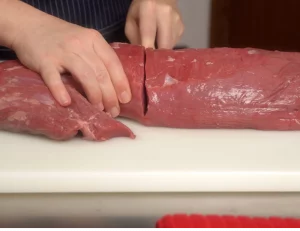
- Salt the filet (fillet) on all sides.fine salt

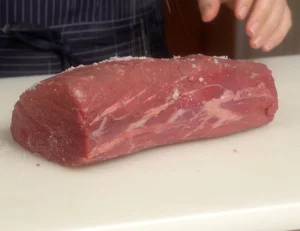
- Wrap the fillet tightly in plastic wrap and let it rest for 2 hours.

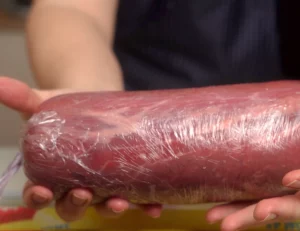
Make the Crêpe
- To make the crêpe batter, beat together the eggs.2 whole eggs
- In another large bowl, mix together the dry ingredients: flour, salt and sugar.1 cup all-purpose flour, ½ tbsp fine salt, 2 tbsp fine granulated sugar
- Add the milk to the flour a little at a time, mixing the batter to a smooth paste each time you add more milk.1 ¼ cup milk
- When all of the milk is added, whisk in the beaten eggs and the melted butter.2 tbsp butter
- Pass the crêpe batter through a sieve (strainer) to remove any clumps that remain in the batter.
- To bake the crêpes: Place a large (buttered) rectangular baking tray (with sides) in a pre-heated 400°F (200°C) oven for 10 minutes.
- Remove the hot baking tray and add a thin layer of crêpe batter over the entire bottom of the baking tray.

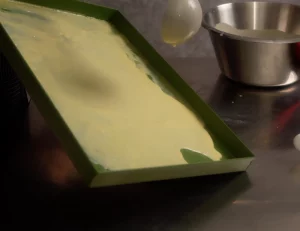
- Return the baking tray to the oven and bake at the same temperature just until the sides of the crêpe begin to pull away from the tray. Remove the baking tray and carefully pull the crêpe off of the tray. Transfer it to parchment paper or a work surface to cool.We only need one large crêpe for this recipe, but continue making crêpes as long as the batter remains in case one tears and you need a backup. Freeze any extra crêpes!

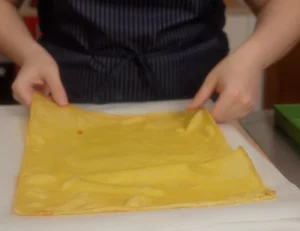
Sear the Filet
- After the 2 hours, it is time to brown the filet! Add a few tablespoons of clarified butter to the bottom of a skillet over high heat. Sear the filet on all sides over high heat until it is browned. The skillet temperature should be roughly 660°F (350°C) to 750°F (400°C), for those with a thermometer.2 tbsp clarified butter

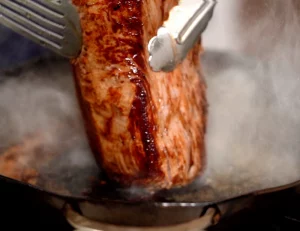
- Deglaze the pan with cognac. Turn the filet over in the cognac to imbue it with extra flavor. This is optional. Save the drippings for use in a sauce, such as a demi-glace!2 tbsp cognac

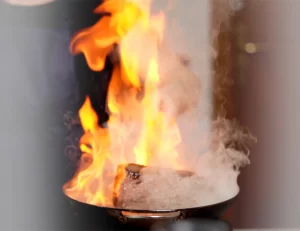
- Let the filet rest to cool before using it to assemble the Beef Wellington

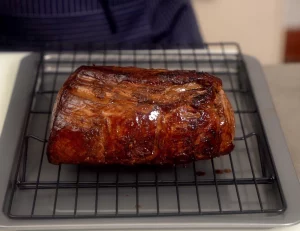
Prepare the Mushroom 'Duxelles'
- Finely mince the (cleaned) mushrooms that you have selected.2.2 lb mixed mushrooms
- Add a few tablespoons of butter to the bottom of a pan or skillet. Then sauté the minced shallots and parsley until the shallots are tender.3 shallots, 2 tbsp butter, 1 handful parsley

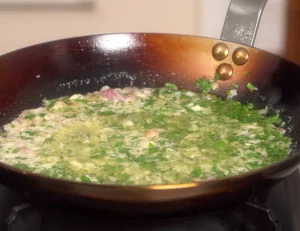
- Combine the sauté with the mushrooms along with a drizzle of olive oil. Then, distribute the minced mushrooms over one or more baking trays.olive oil

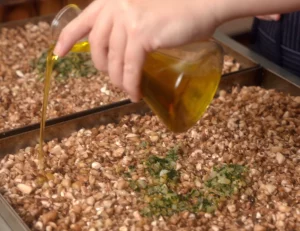
- Bake the mushrooms in the oven (fan) at 350° F (180° C), stirring frequently. Bake until the mushrooms have shrunk, but are still tender.

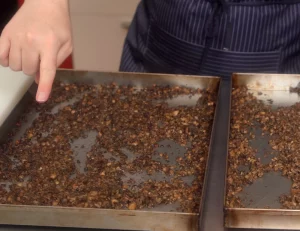
- Let the mushrooms cool, then add any extra boost of flavor such as a few tablespoons of truffle sauce or a bit of truffle oil. Salt to taste—but remember that the prosciutto that will be next to the mushrooms is very salty!2 oz truffle sauce

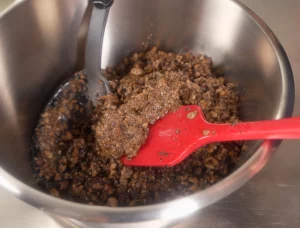
Assemble the Beef Wellington
- Lay the large crêpe on a flat surface. Determine where to trim the crêpe by doing a test wrap with the beef filet. Cut the crêpe to allow for a bit of overlap. Cover the crêpe with one thin layer of prosciutto, overlapping the prosciutto slices if necessary.6 oz sweet prosciutto

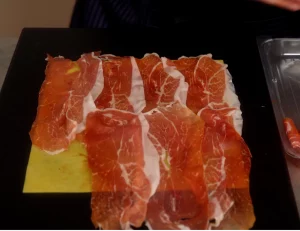
- Spread the mushroom 'duxelles' over the prosciutto. Leave just a bit of the crêpe uncovered at one end if you want to slightly overlap the crêpe around the filet to get a tight seal (optional).

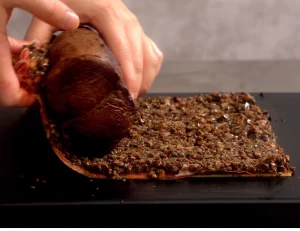
- Place the seared beef filet on the mushrooms and wrap the crêpe around the filet. The ends of the crêpe should hug together tightly at the seam.
- Wrap the entire Beef Wellington in plastic wrap. (See the video for the best technique for ensuring a tight wrap.)

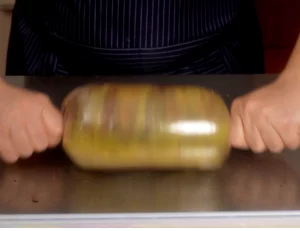
- Let the Beef Wellington rest for at least ½ an hour. This will help the Beef Wellington to hold its shape when we wrap it in puff pastry.
Wrap the Wellington with Puff Pastry
- Lay one piece of puff pastry —40cm x 30cm (16″ x 12″)— on a flat work surface. Remove the plastic wrap from the Beef Wellington and test wrap it in pastry to determine where to trim the pastry.
- Make an egg wash by beating together the egg yolks and cream. Brush a thin layer of egg wash over the top side of the puff pastry.2 yolks eggs, 1 tbsp heavy cream
- Place the crêpe-wrapped Beef Wellington on top of the egg wash. Then tightly wrap the puff pastry around the entire thing. There should be puff pastry overhang on the sides of the Beef Wellington, but very little overlap where the edges of the puff pastry meet.

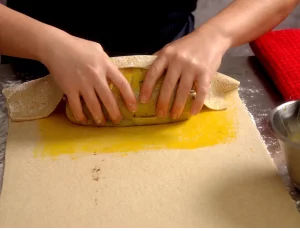
- Press the top of the puff pastry down along each side (against the filet) to cover the sides of the Beef Wellington. Trim the excess pastry on the bottom, leaving about 2 inches to fold under.

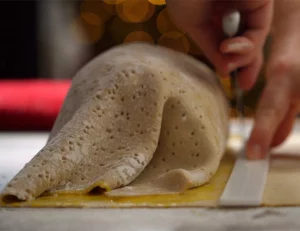
- Use a fork to press down on the pastry sticking out on the sides (to seal). Then fold that excess dough under the Beef Wellington.

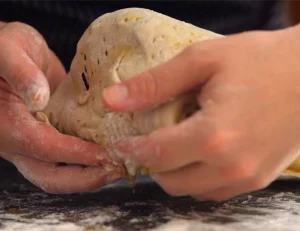
- Cover the entire puff pastry on the outside another thin layer of egg wash.

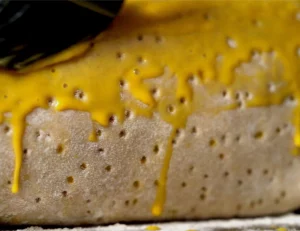
Add Puff Pastry Decoration to the Beef Wellington (OPTIONAL)
- With the second sheet of puff pastry —sized 40cm x 30cm (16″ x 12″)— cut whatever decoration you like.We use a lattice roller cutter to do the job. If you are using this tool, gently stretch out the cut pastry (it will resemble a net) and drape it over the Beef Wellington.

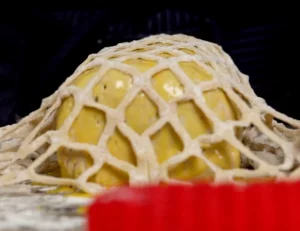
- Trim as needed on the bottom.

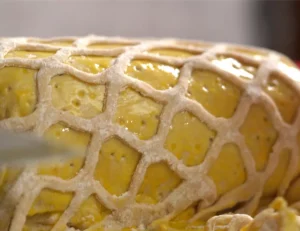
- Then, cover the decoration with a thin layer of egg wash.

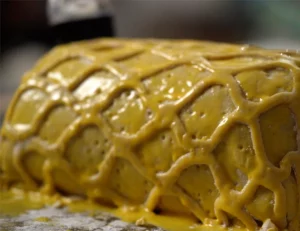
Bake the Beef Wellingon
- Transfer the entire Beef Wellington to a baking tray with sides.To bake the Beef Wellington: Pre-heat the oven (static) to 400° F (200° C). For a medium-rare beef, bake for 20 – 25 minutes.

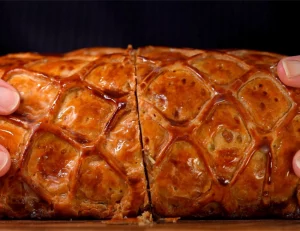
- It's best to use a meat thermometer rather than a timer to determine if your Beef Wellington is done as you like. The puff pastry should be golden. For a medium-rare doneness, the internal temperature of the meat should be 118° F (48° C). Please see the notes for more about FDA recommendations.Buon appetito!

